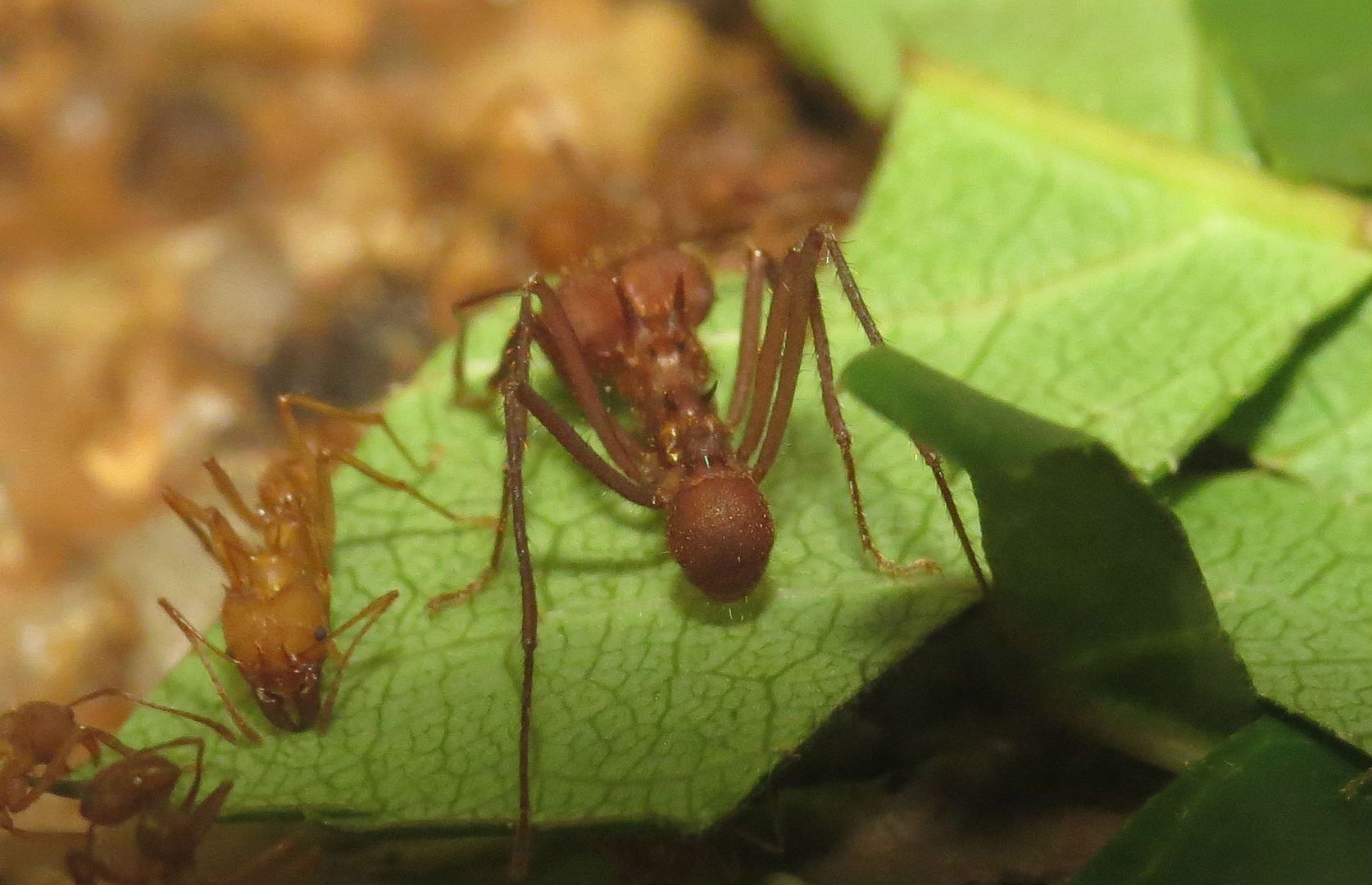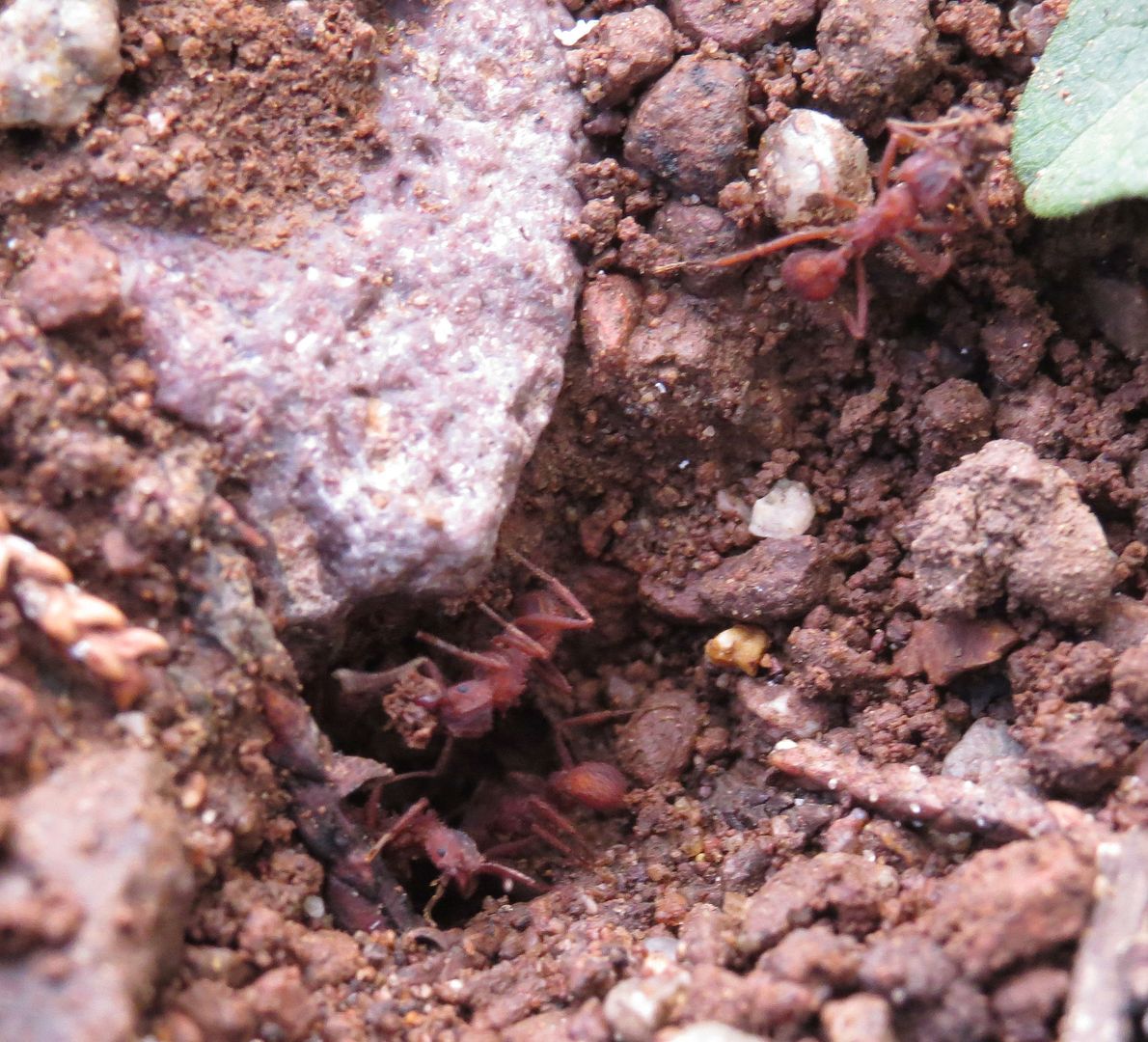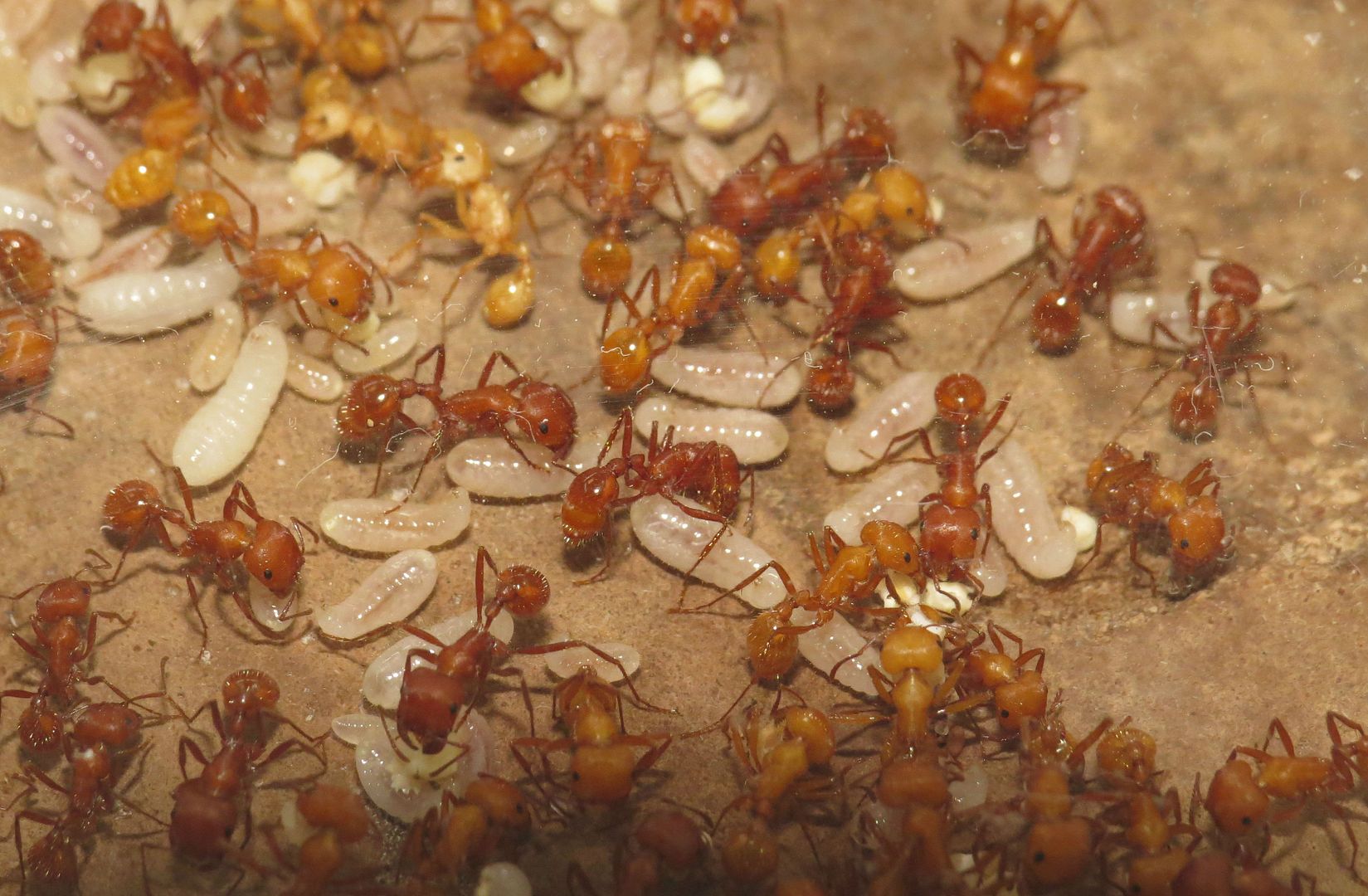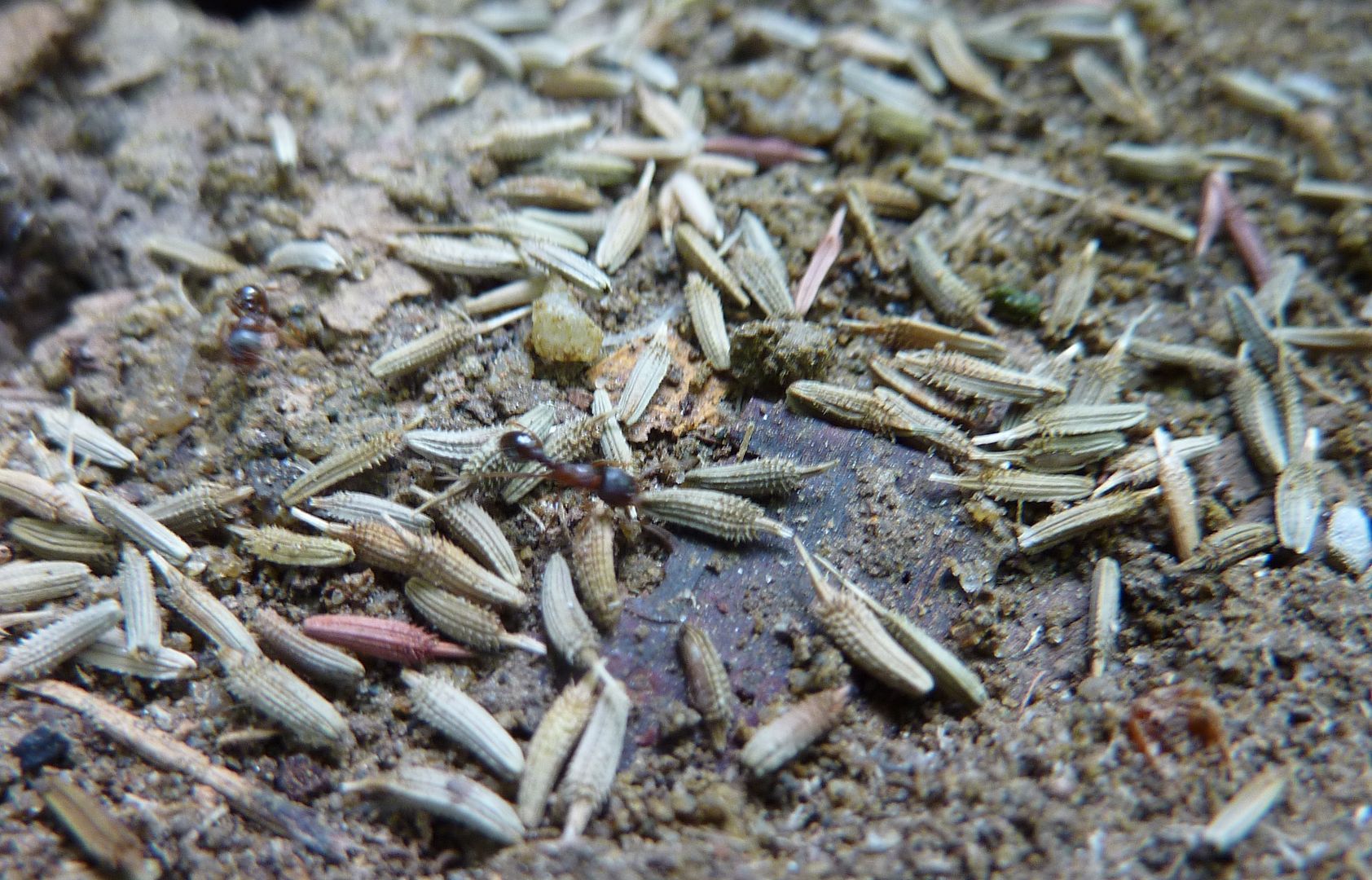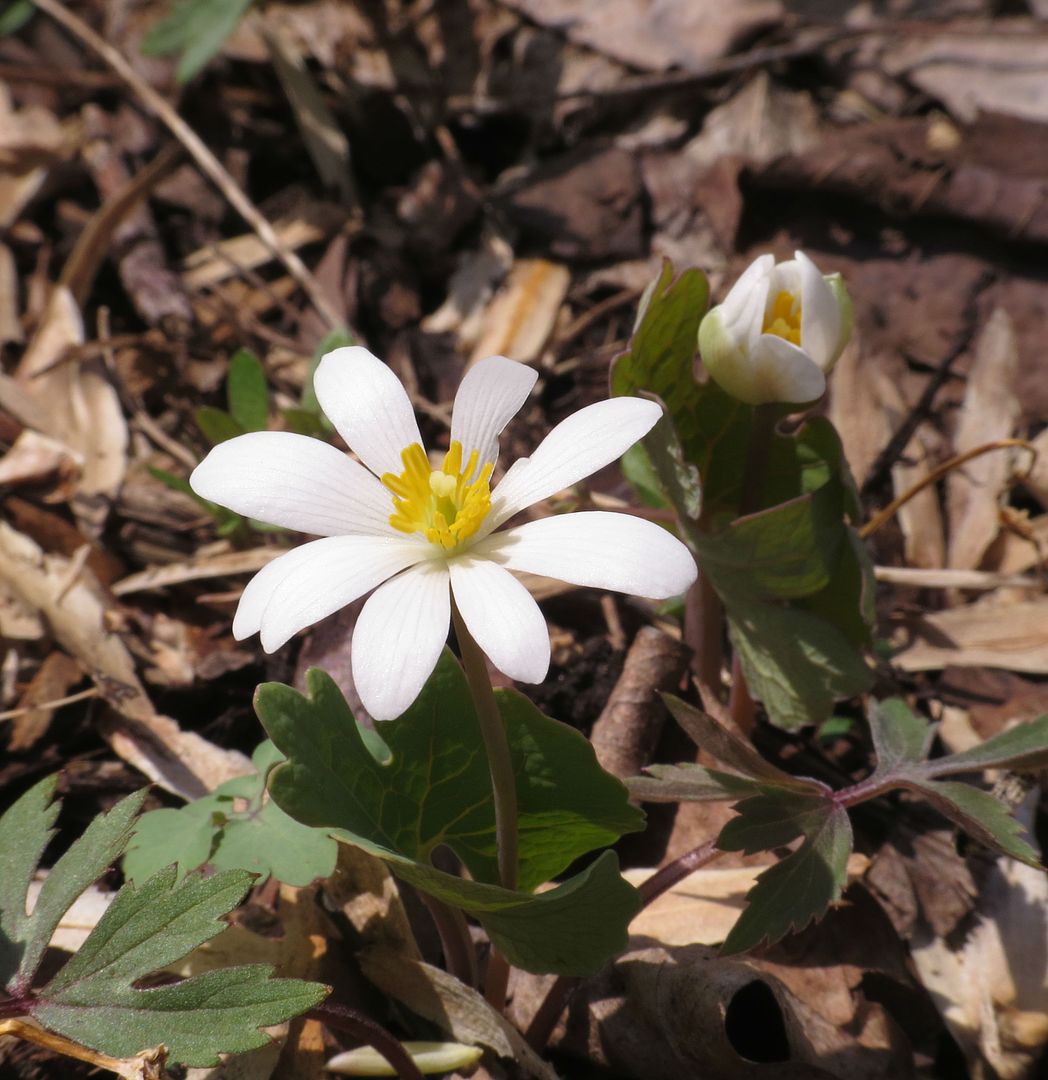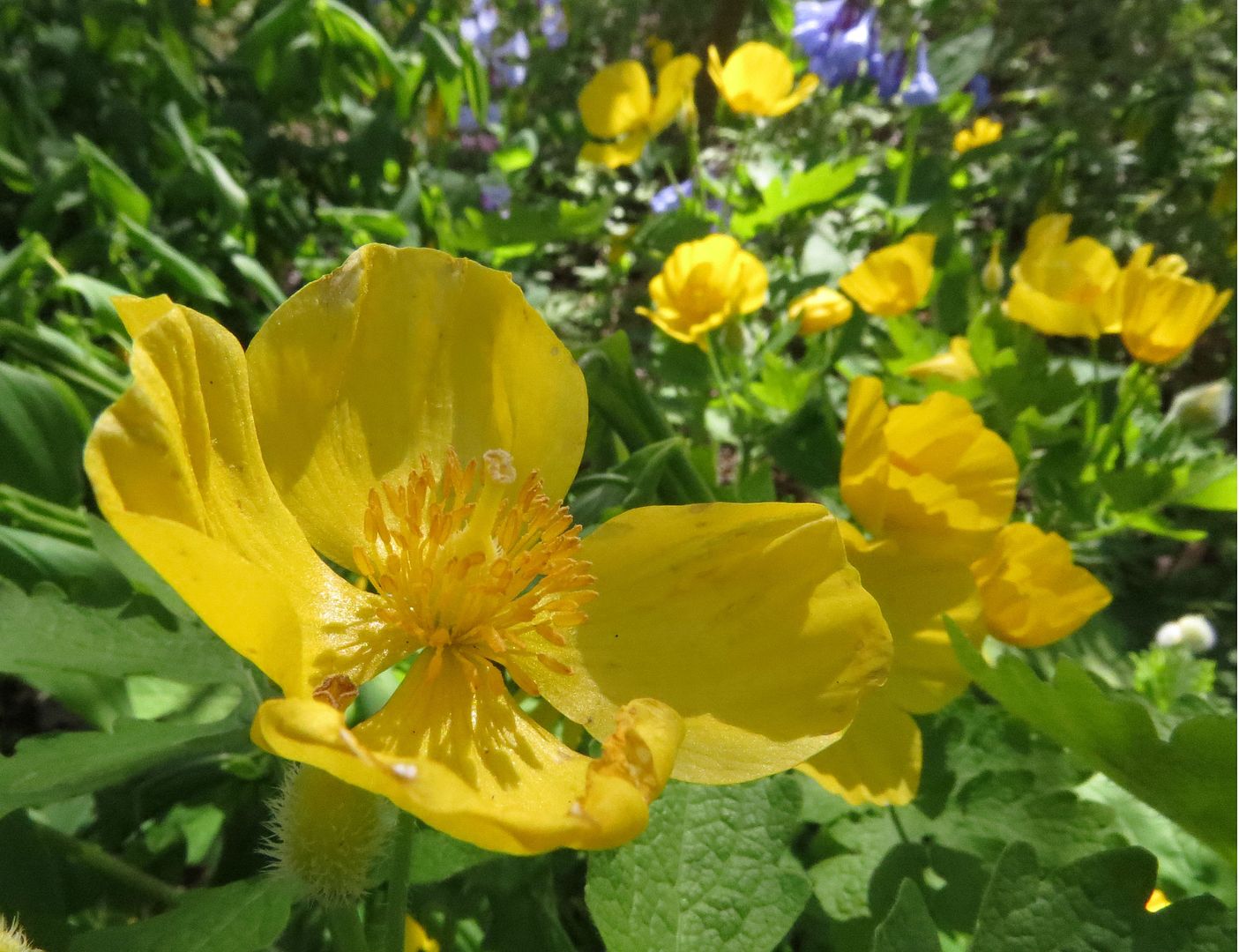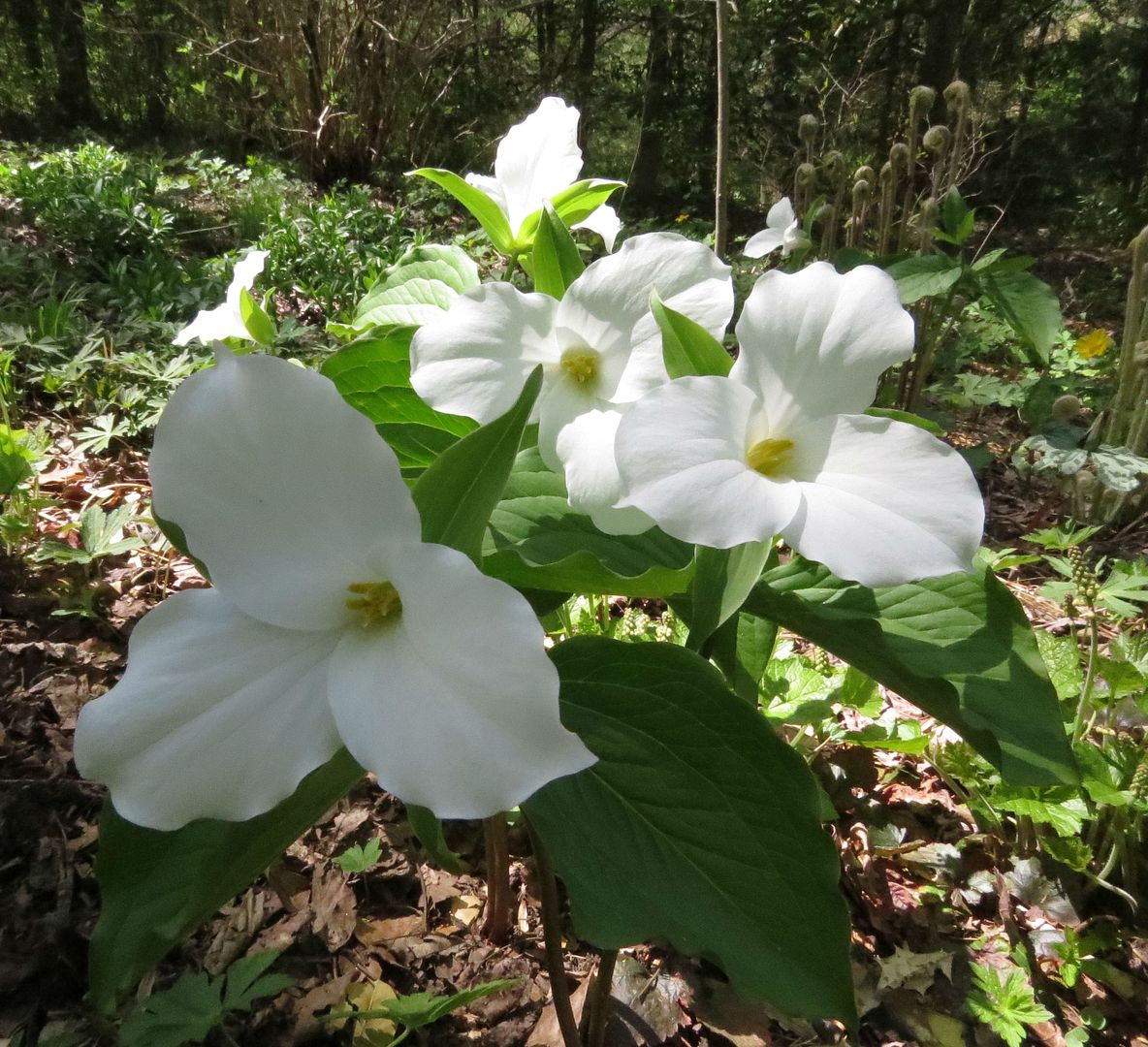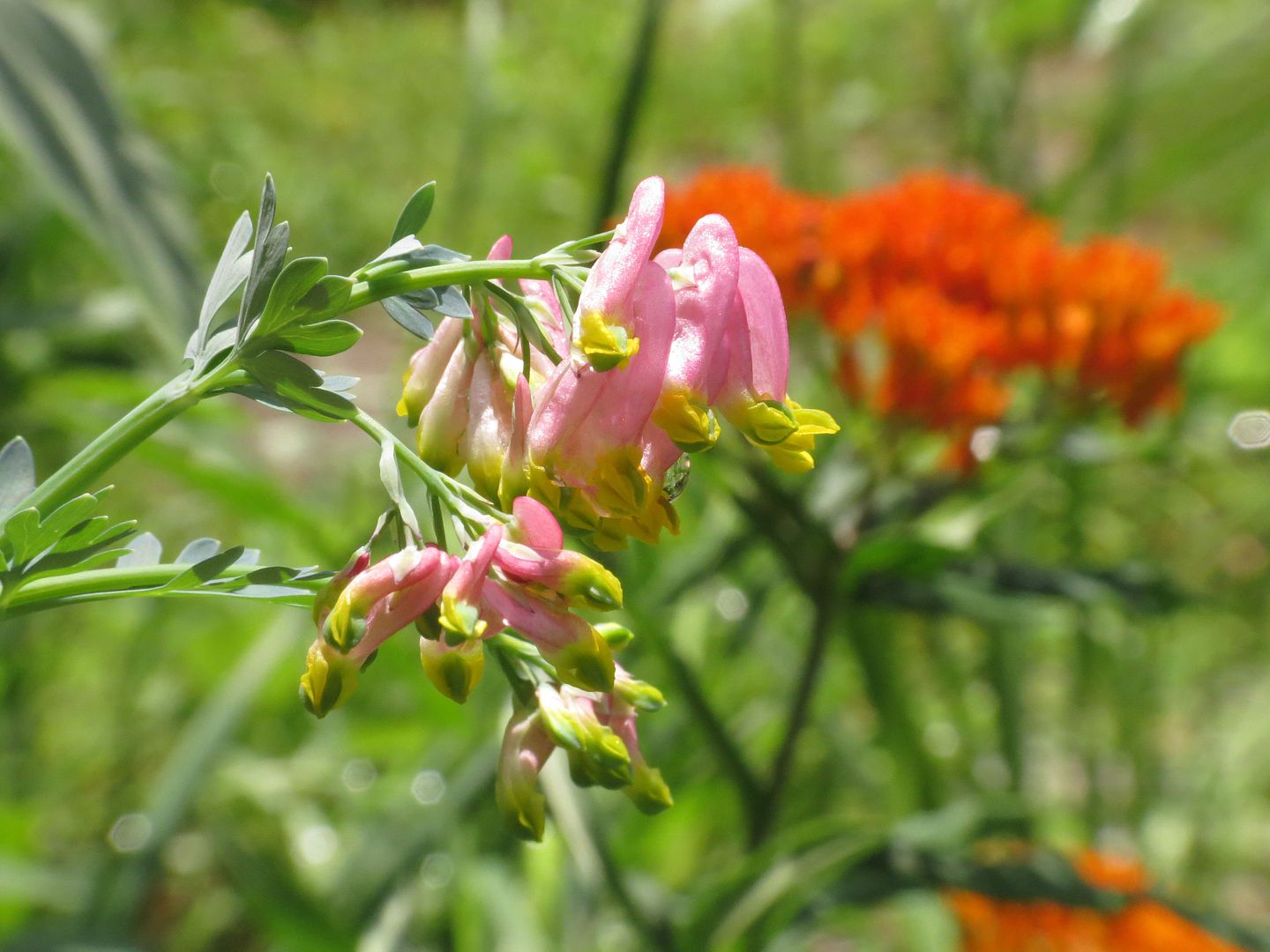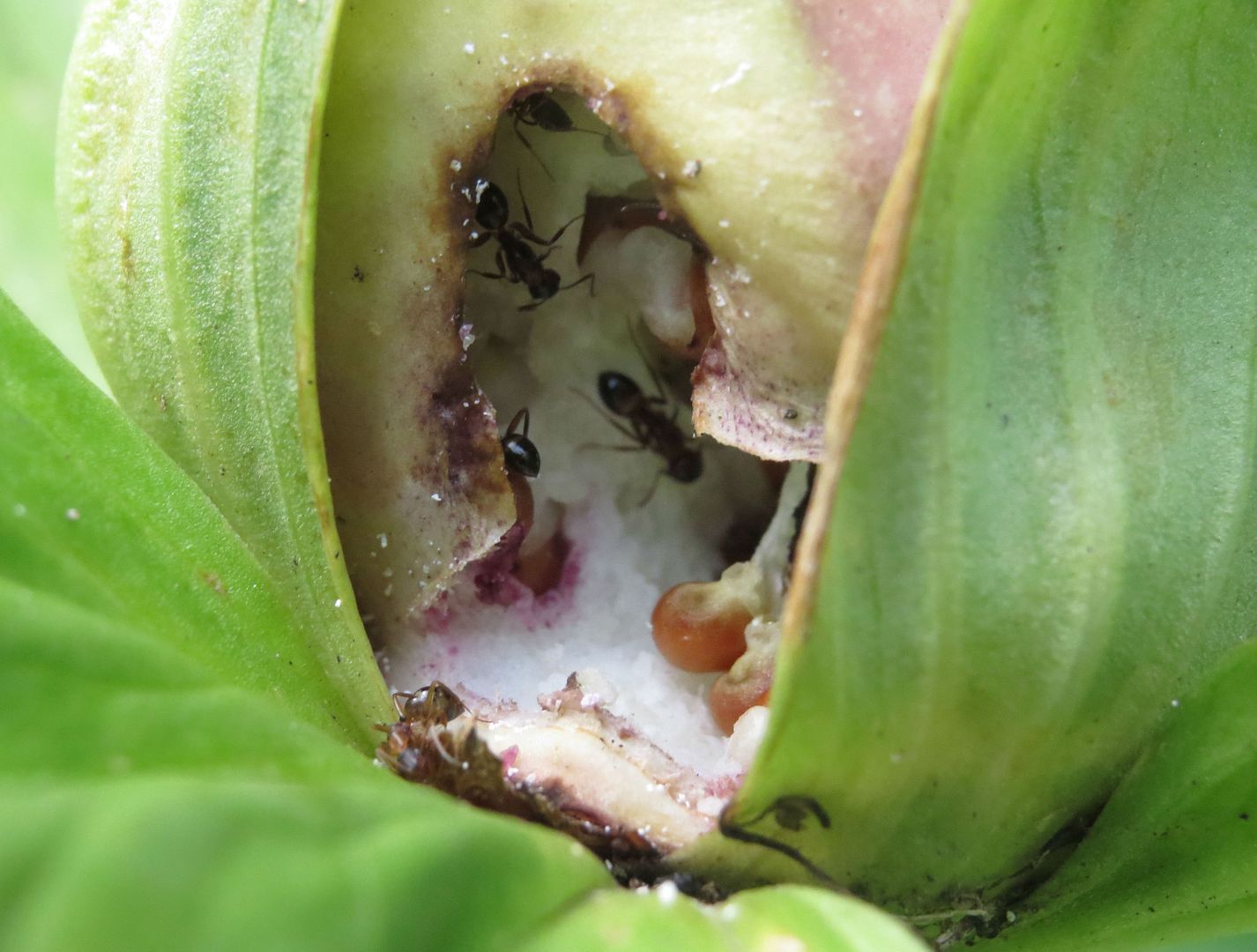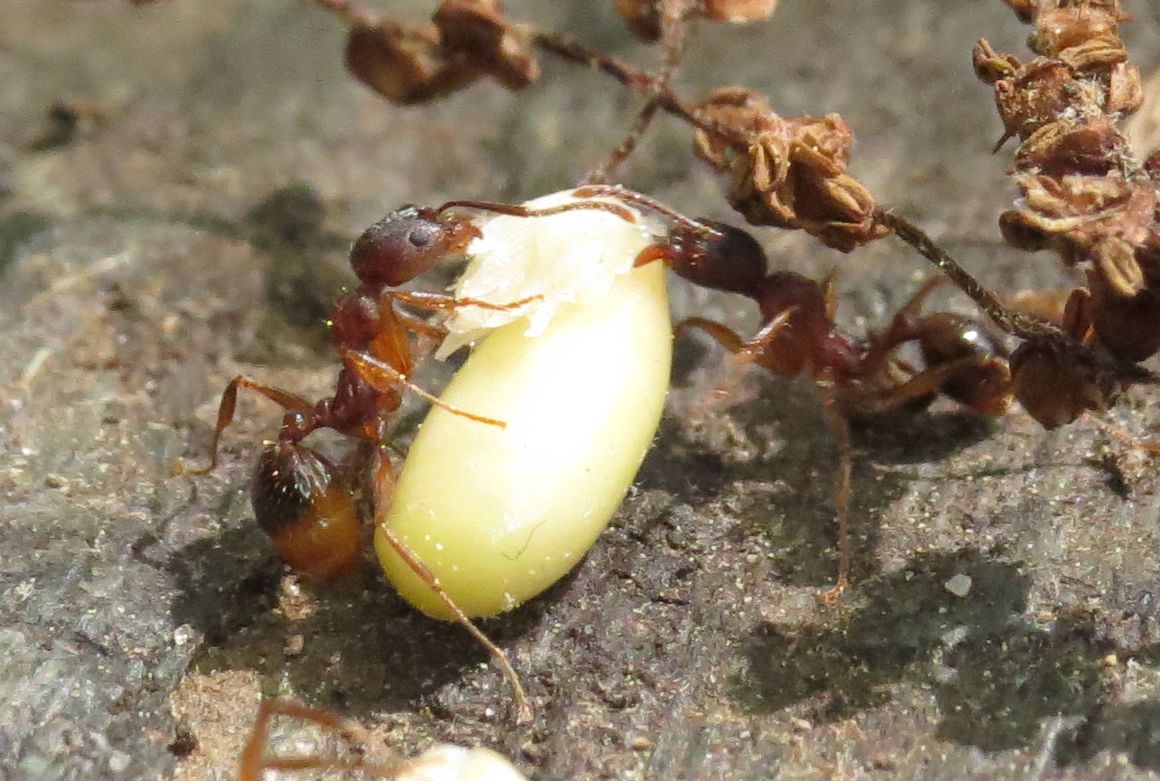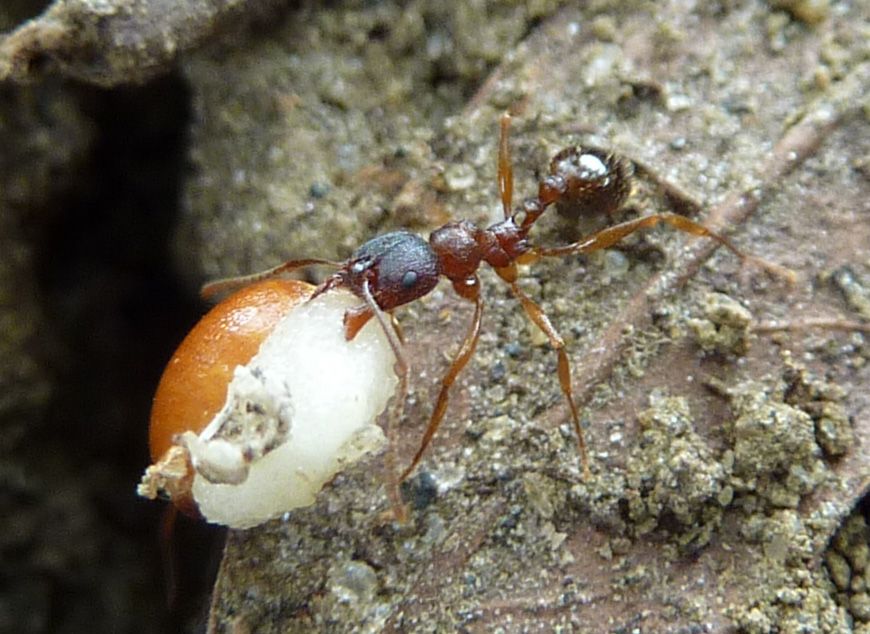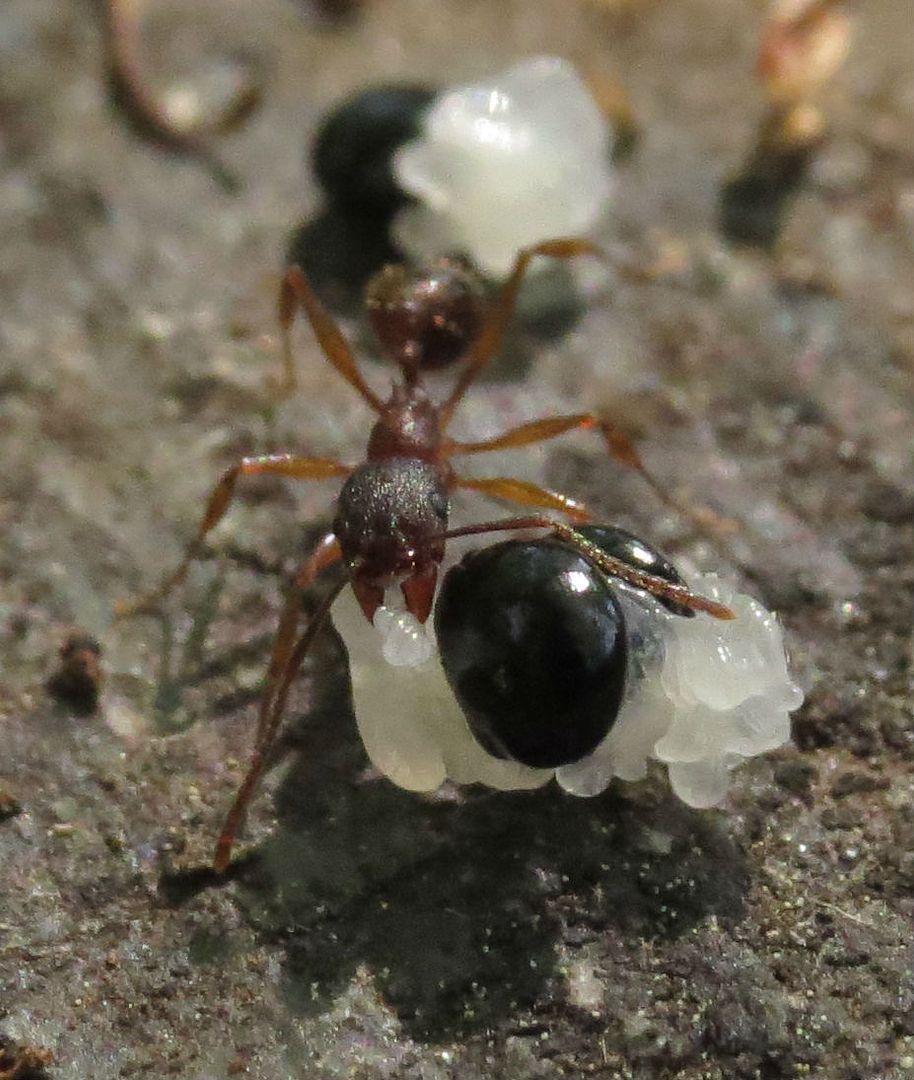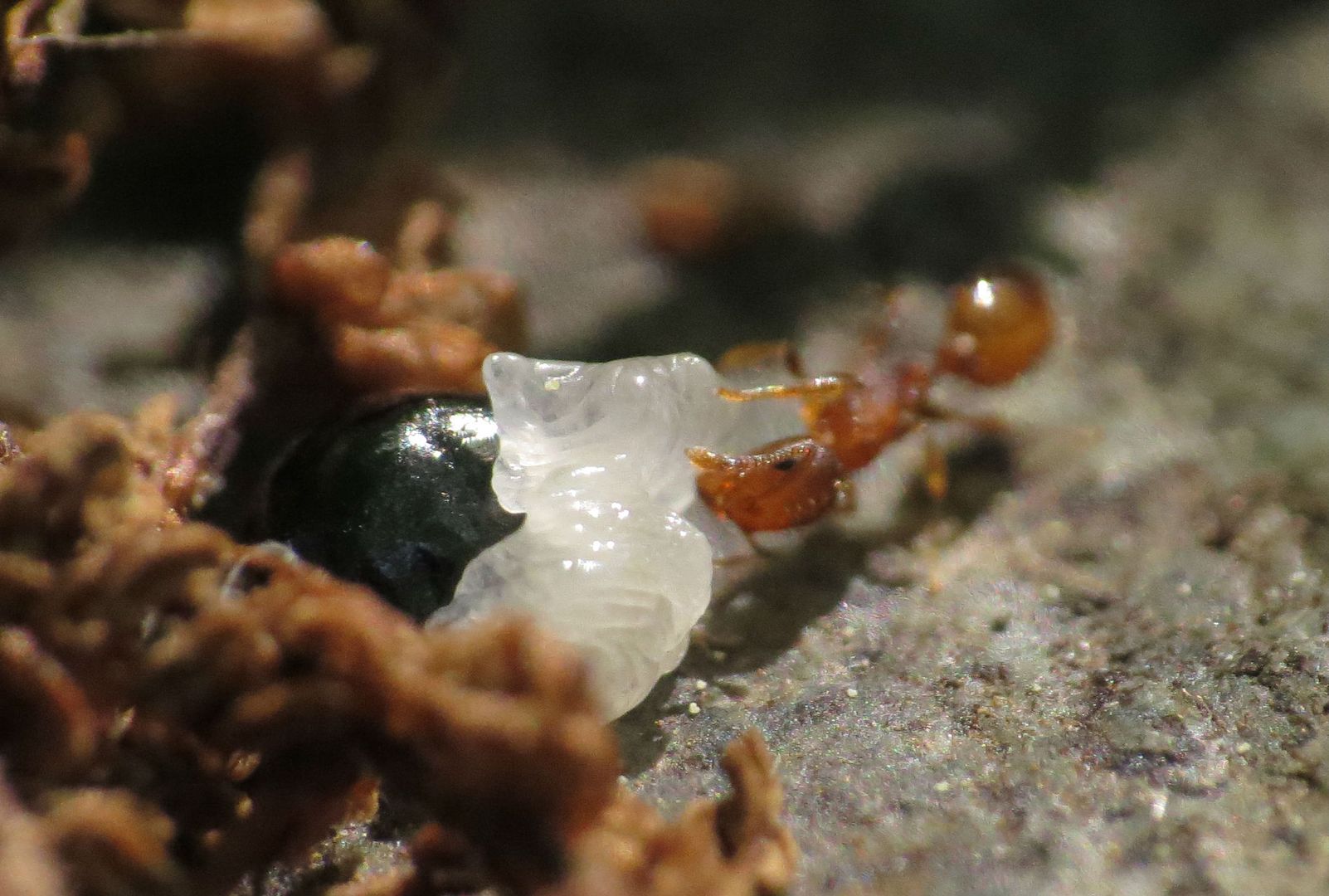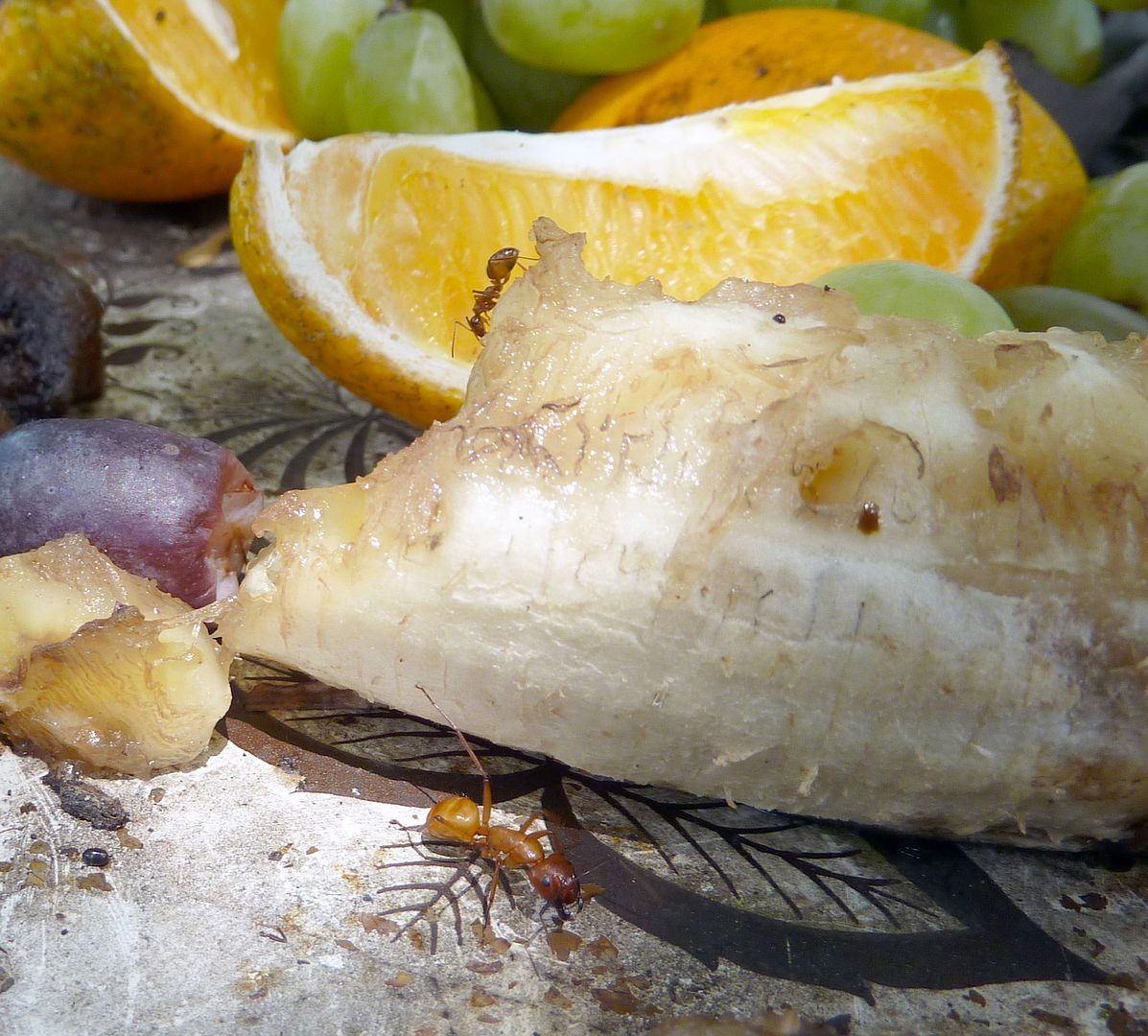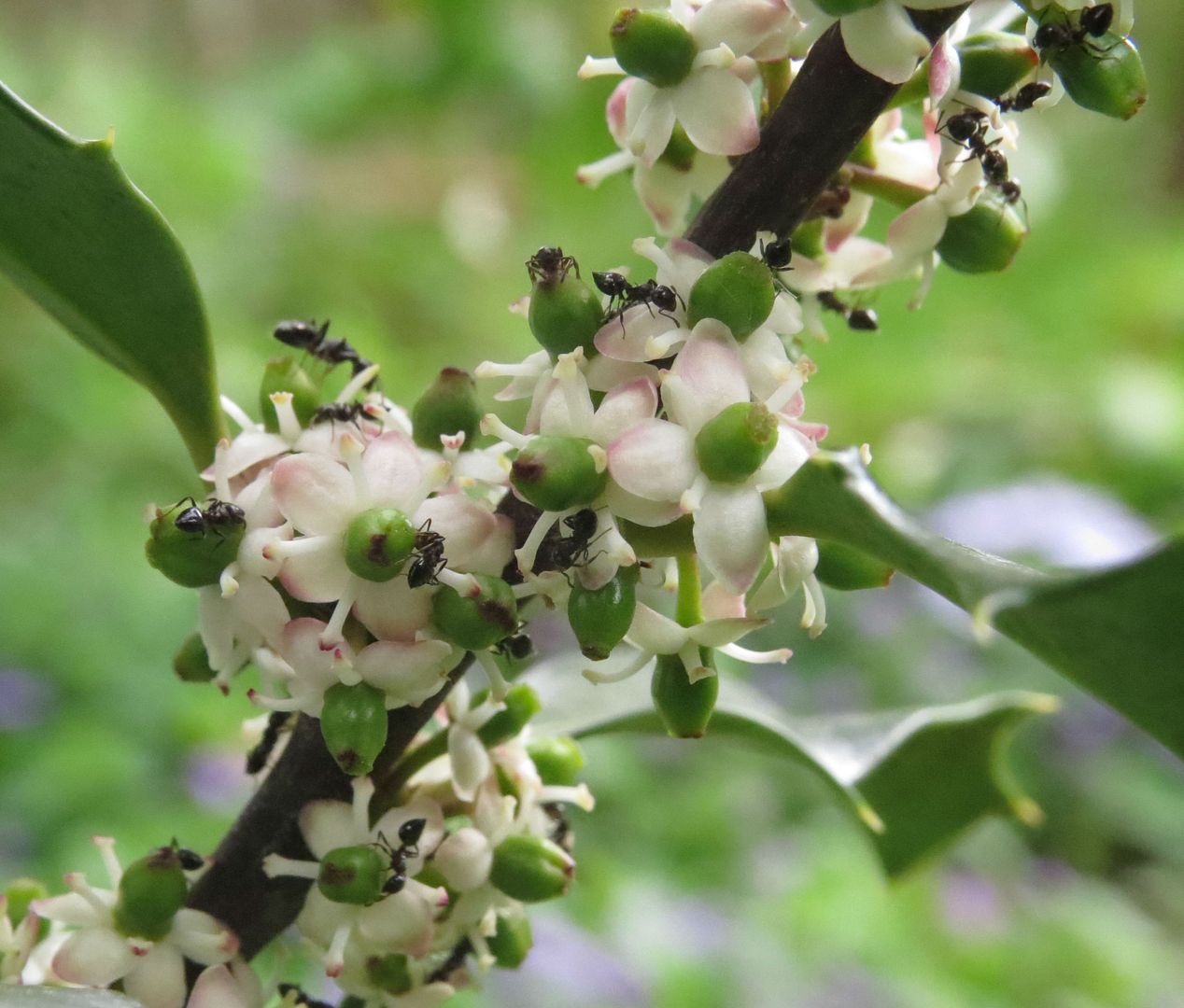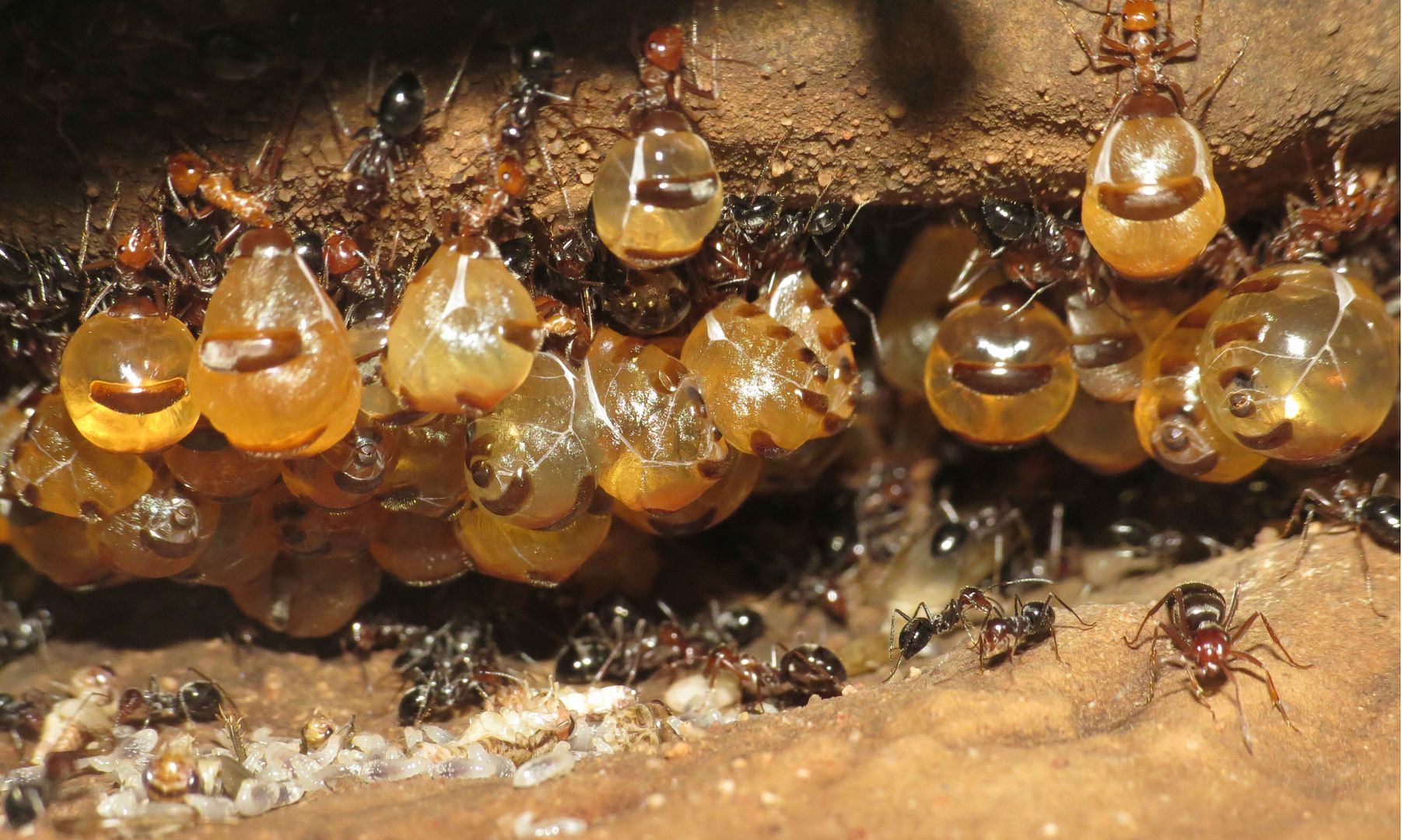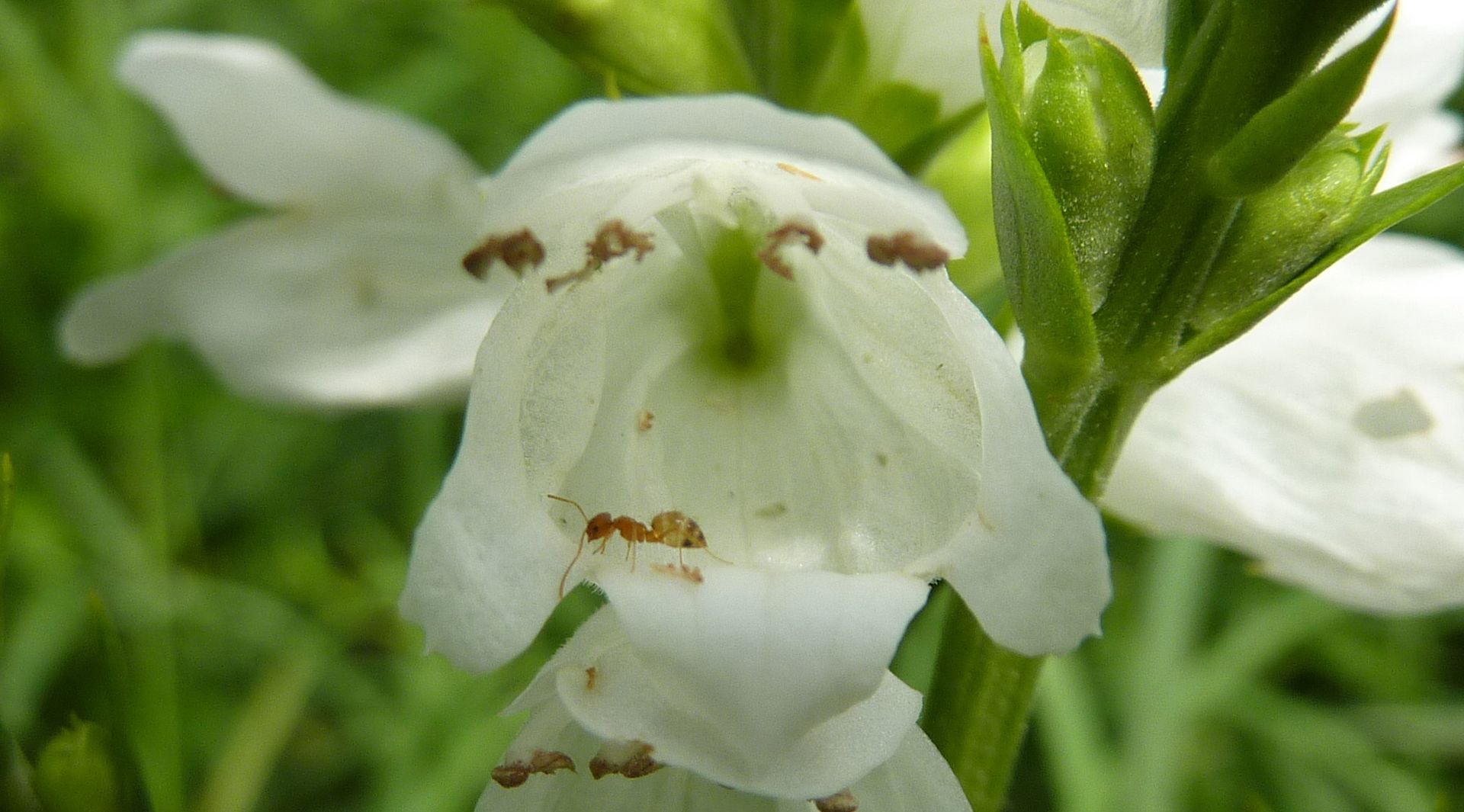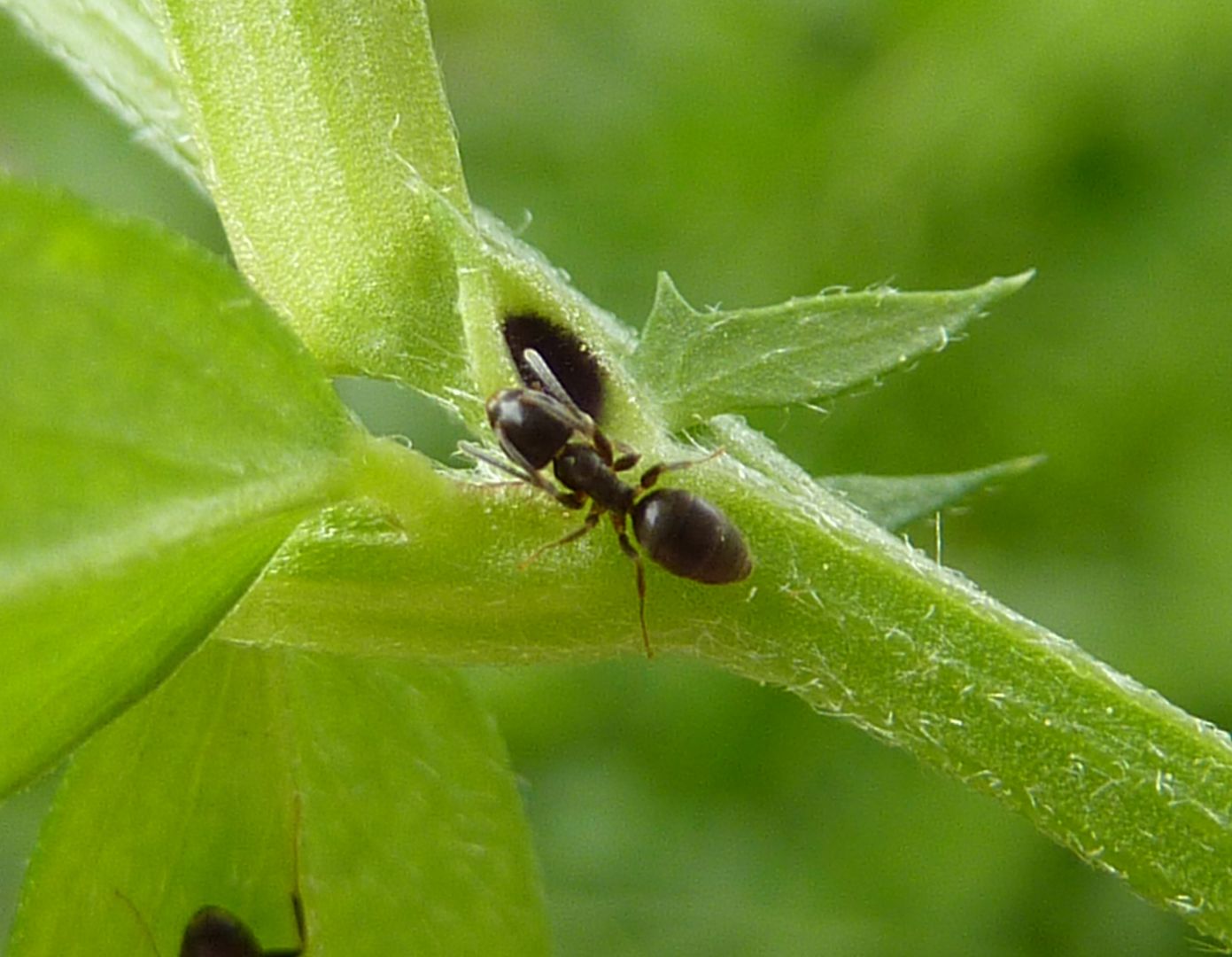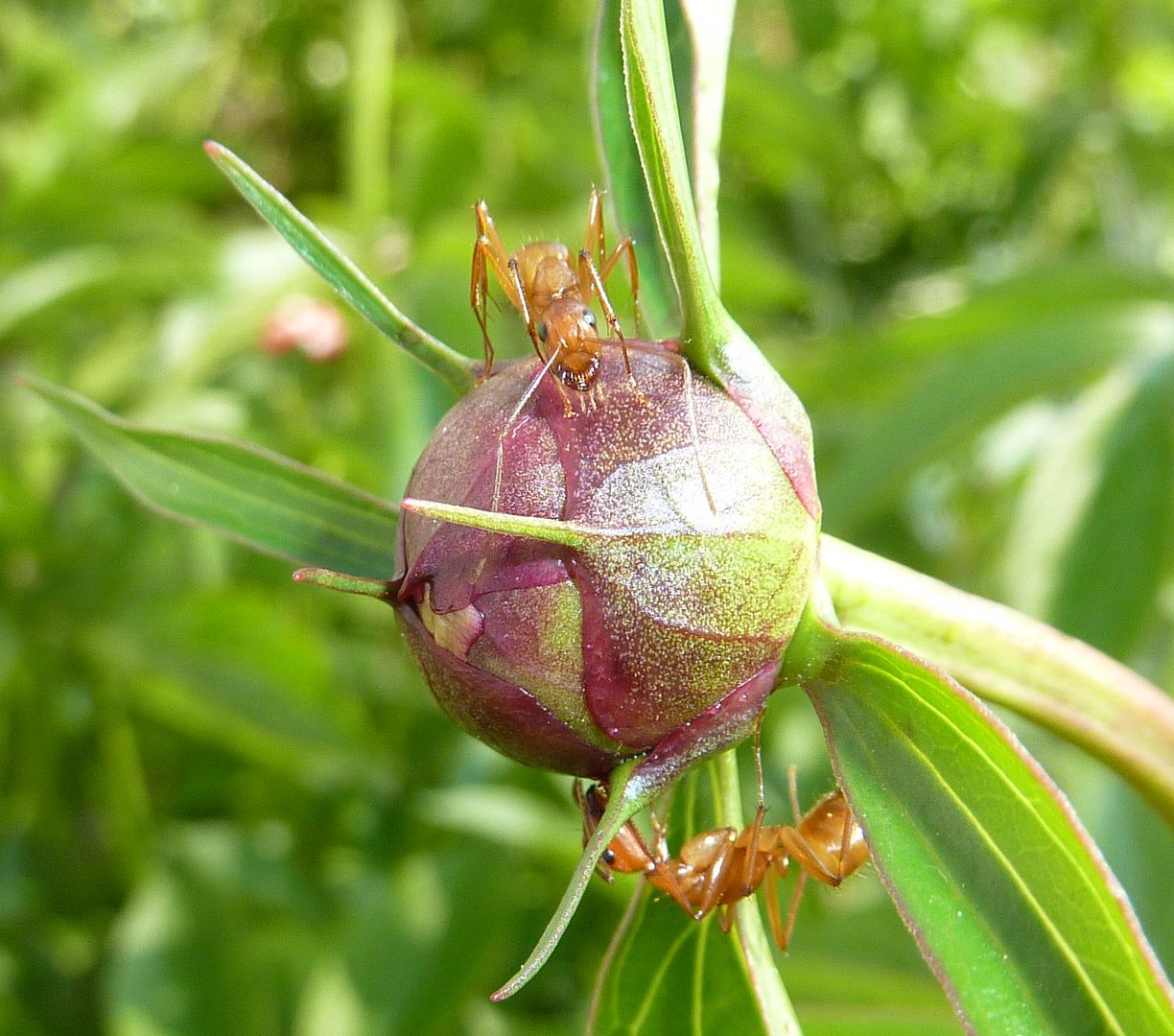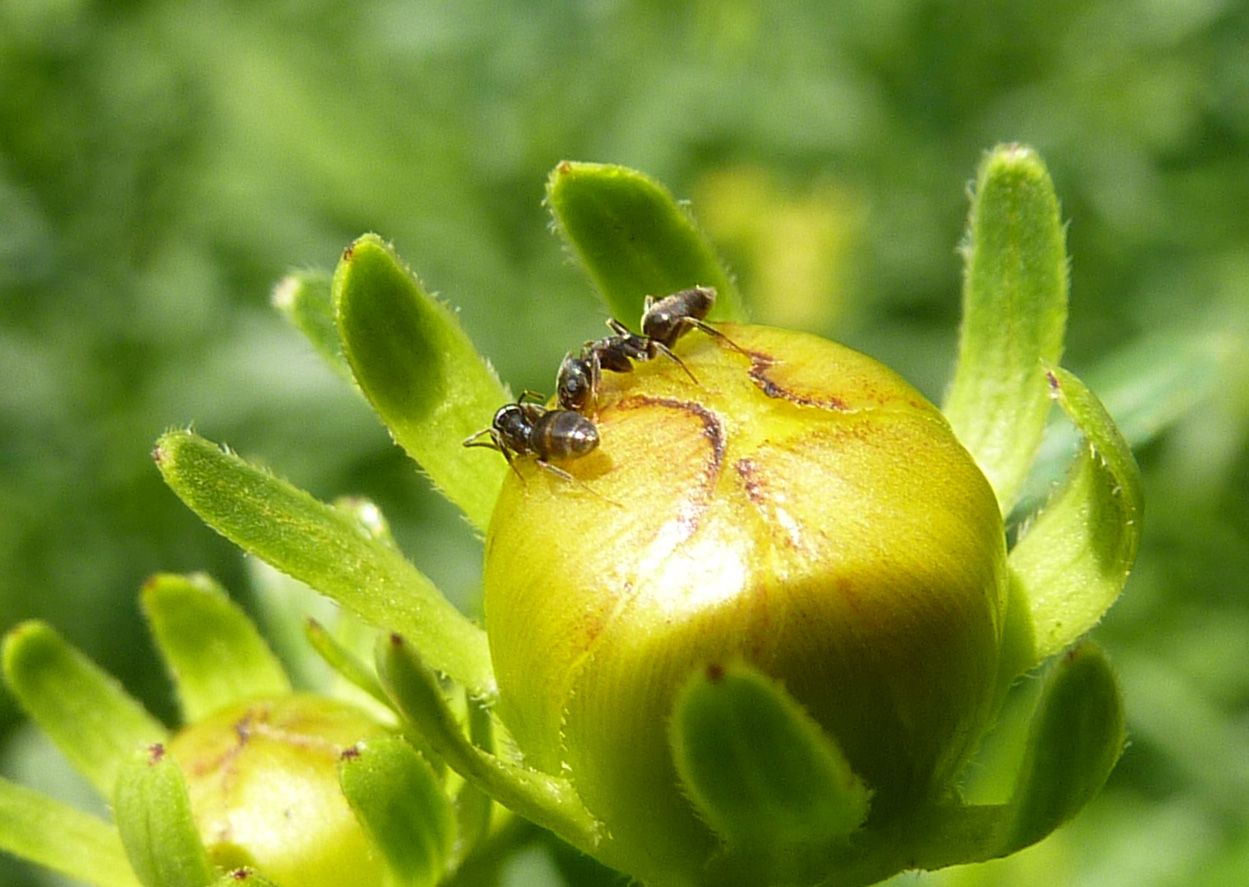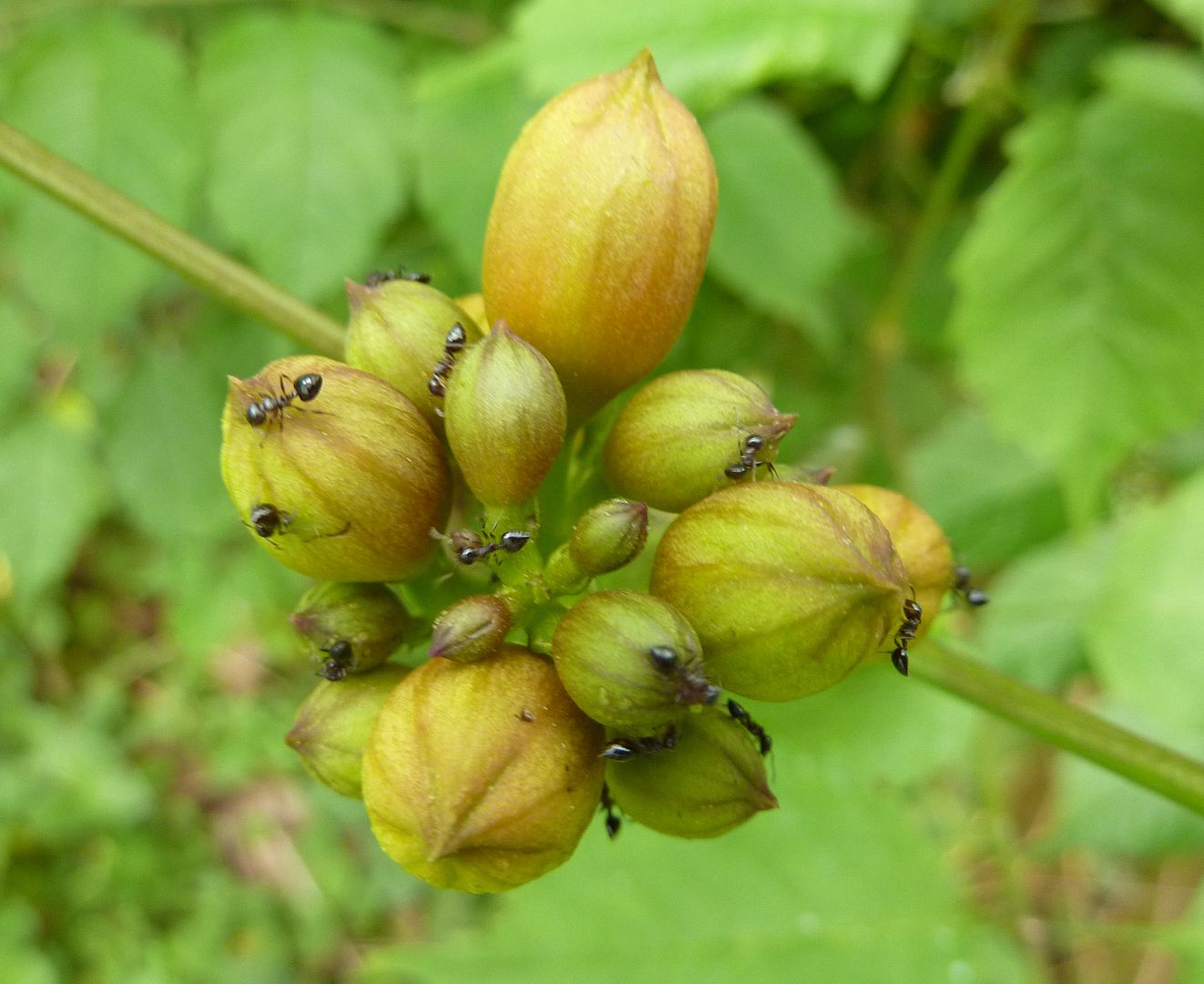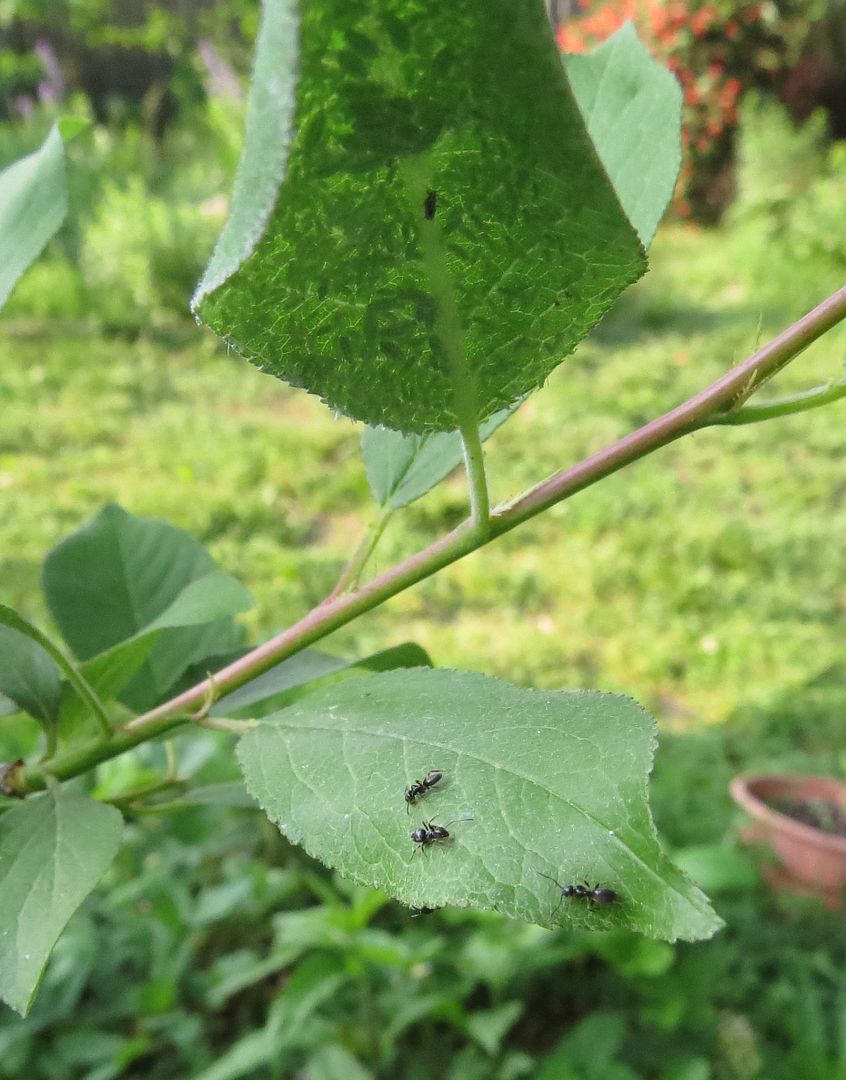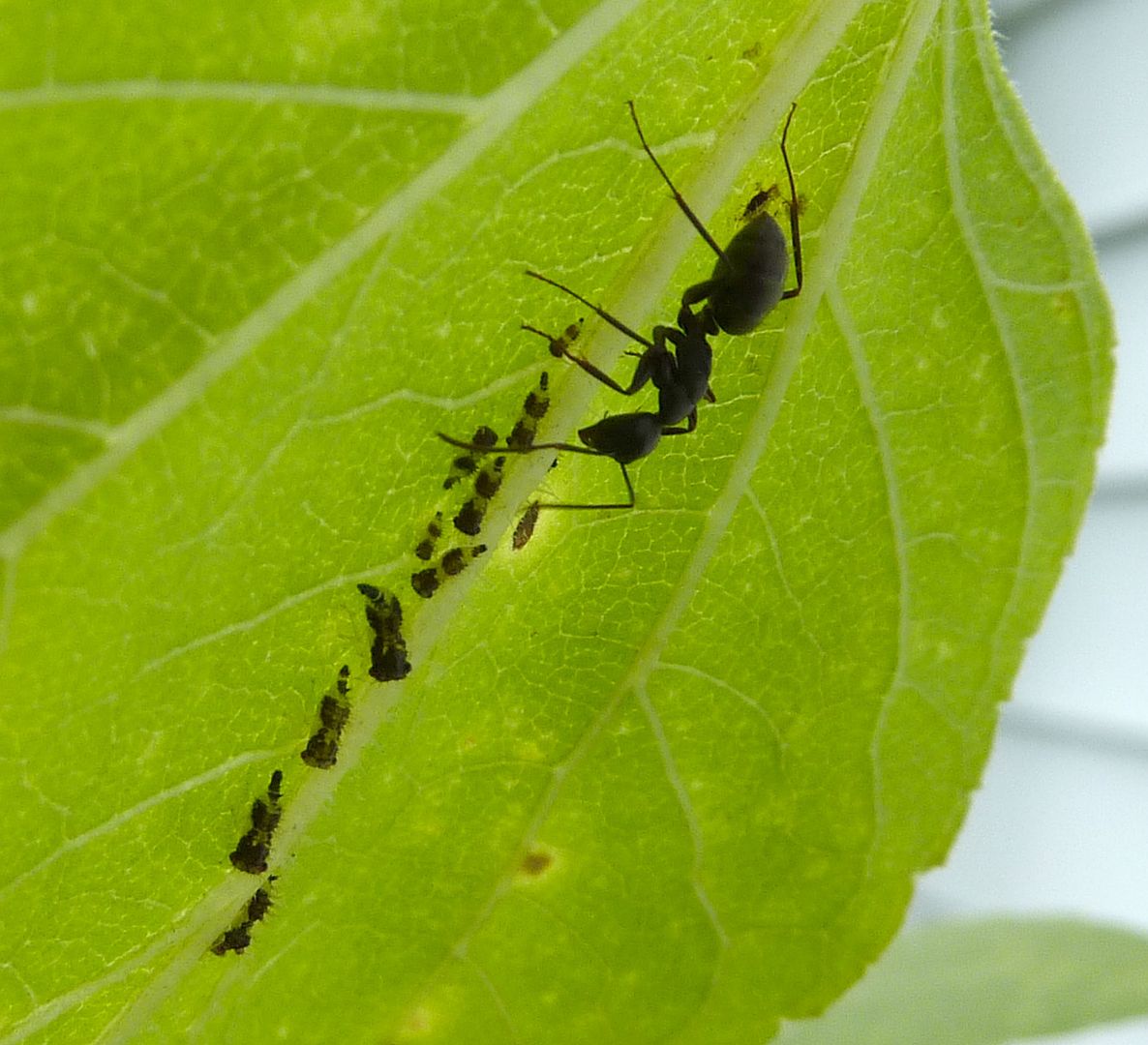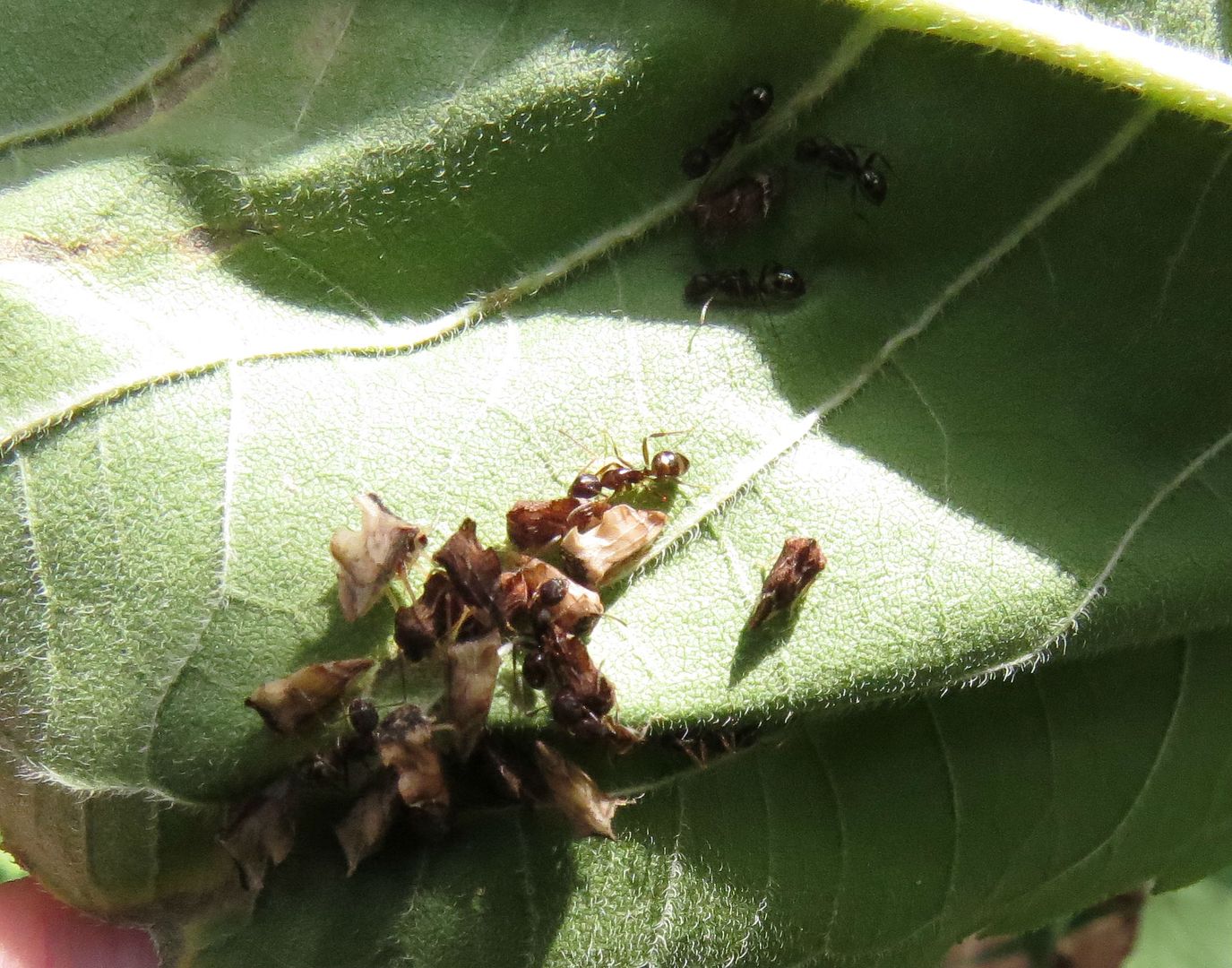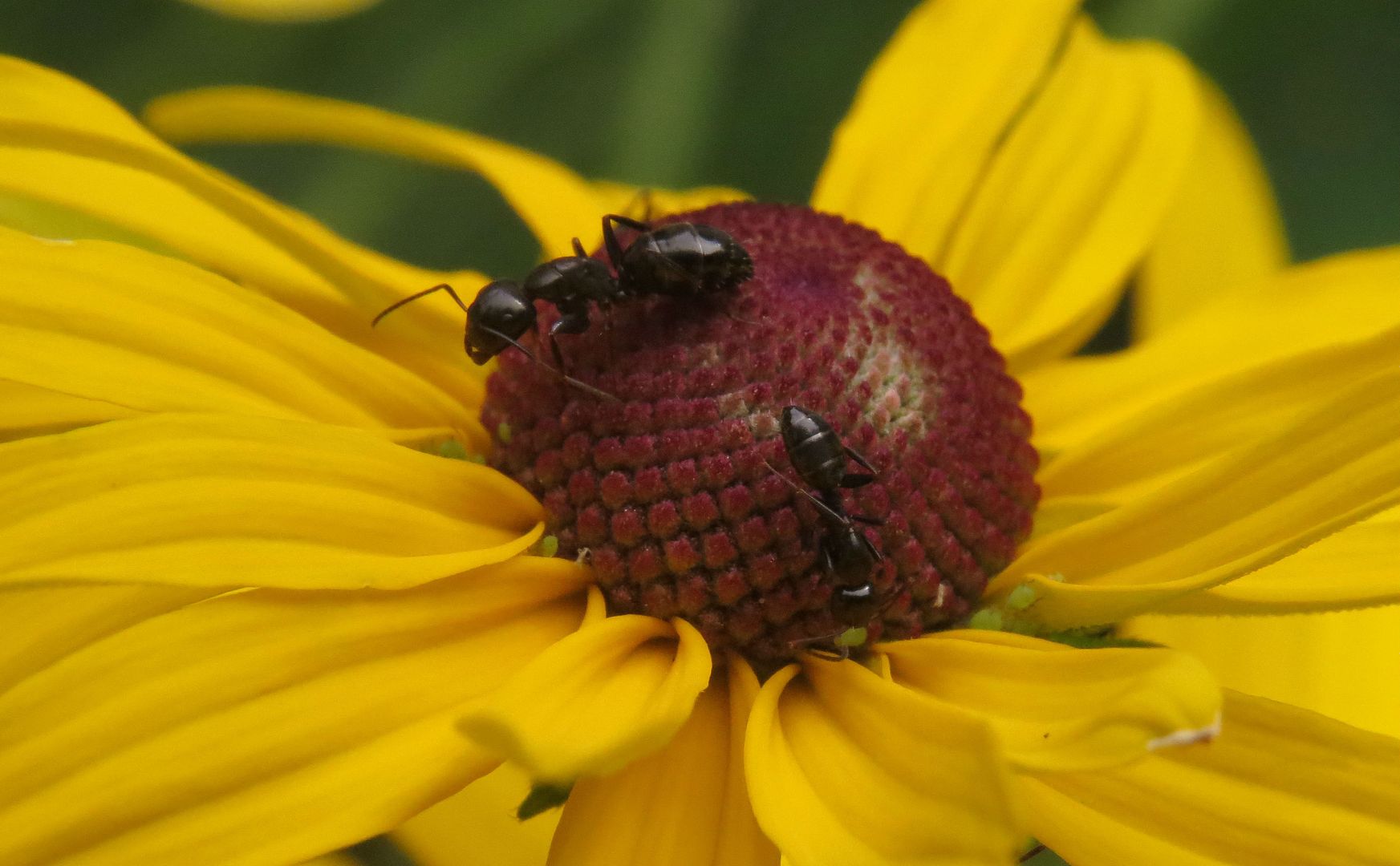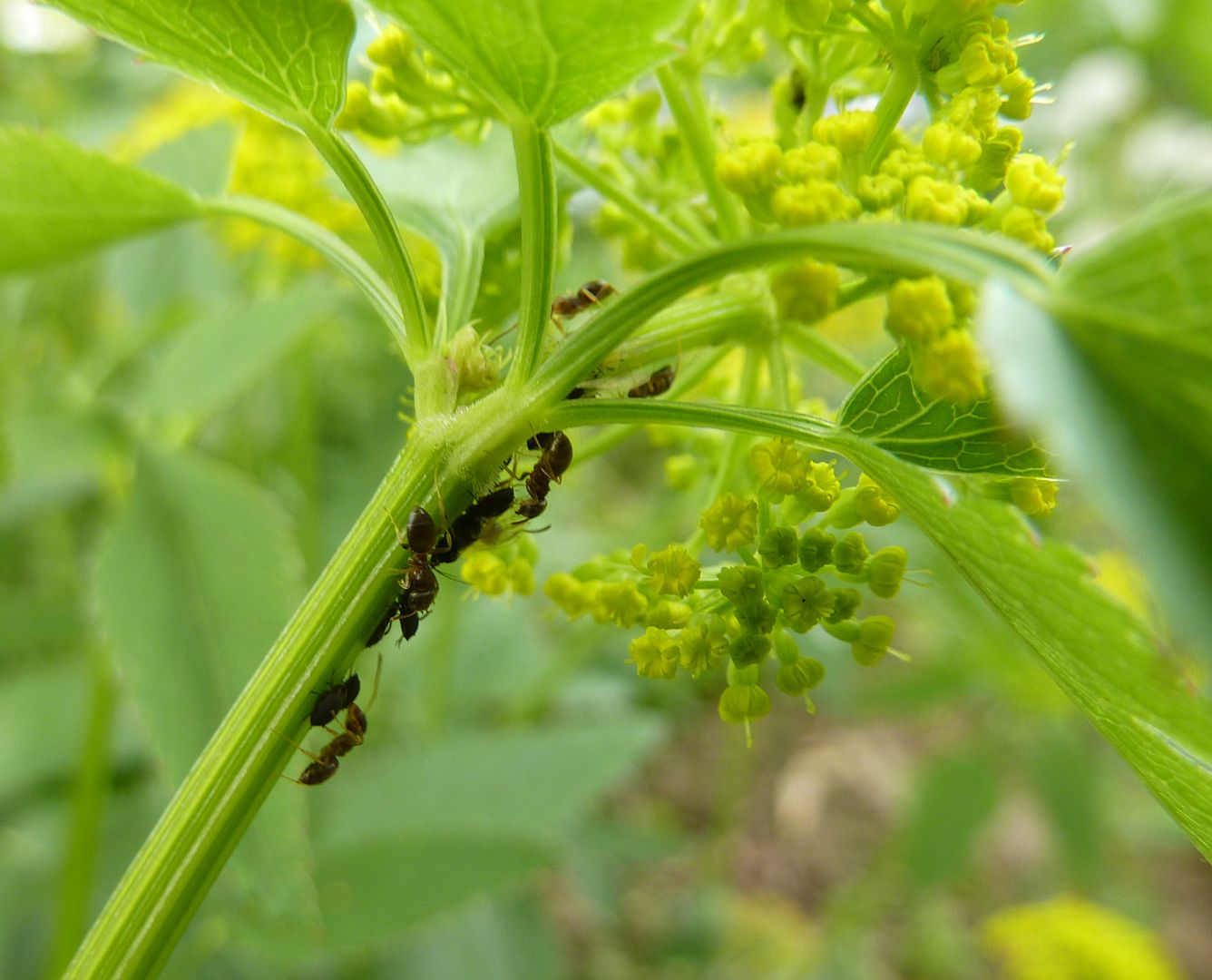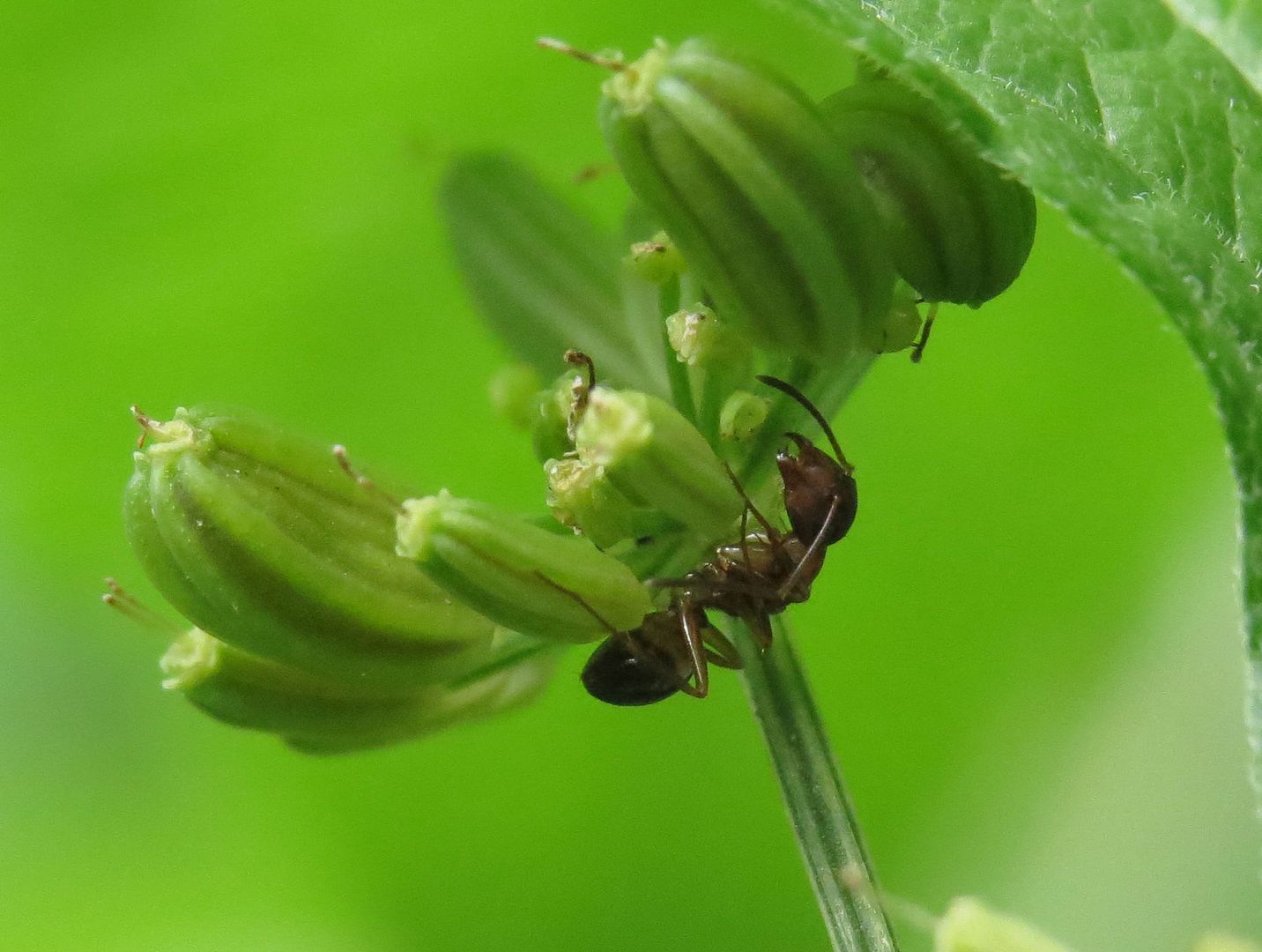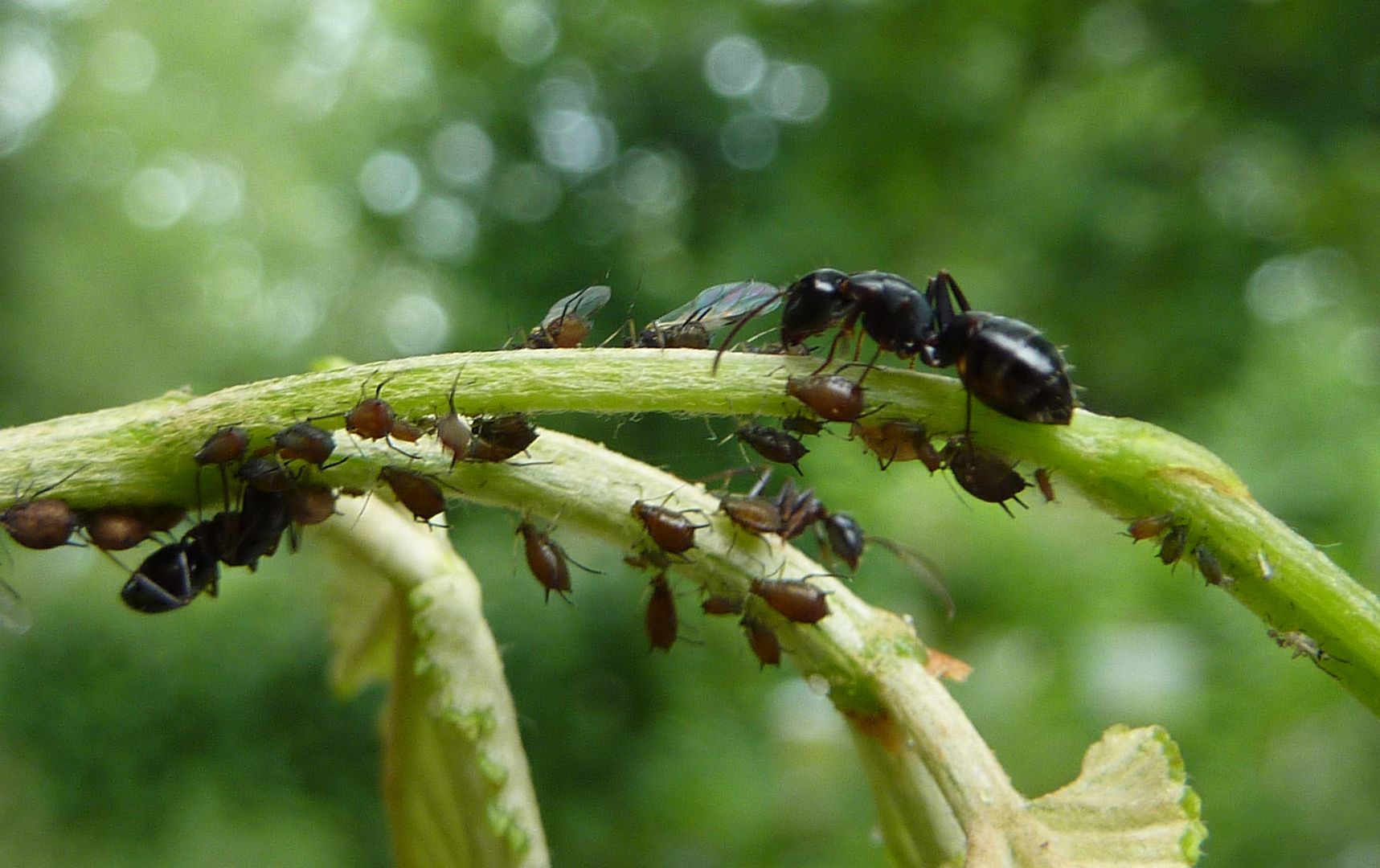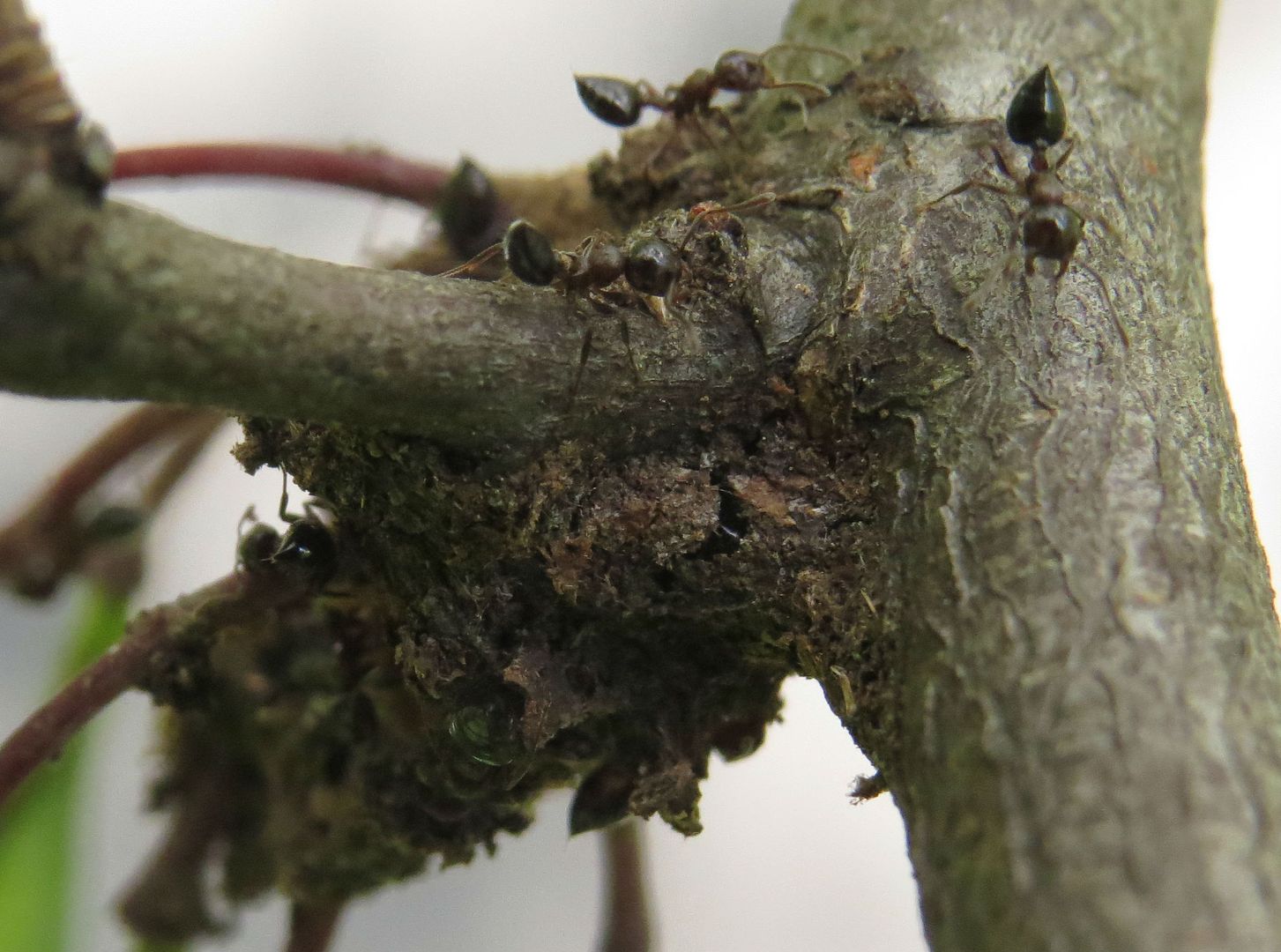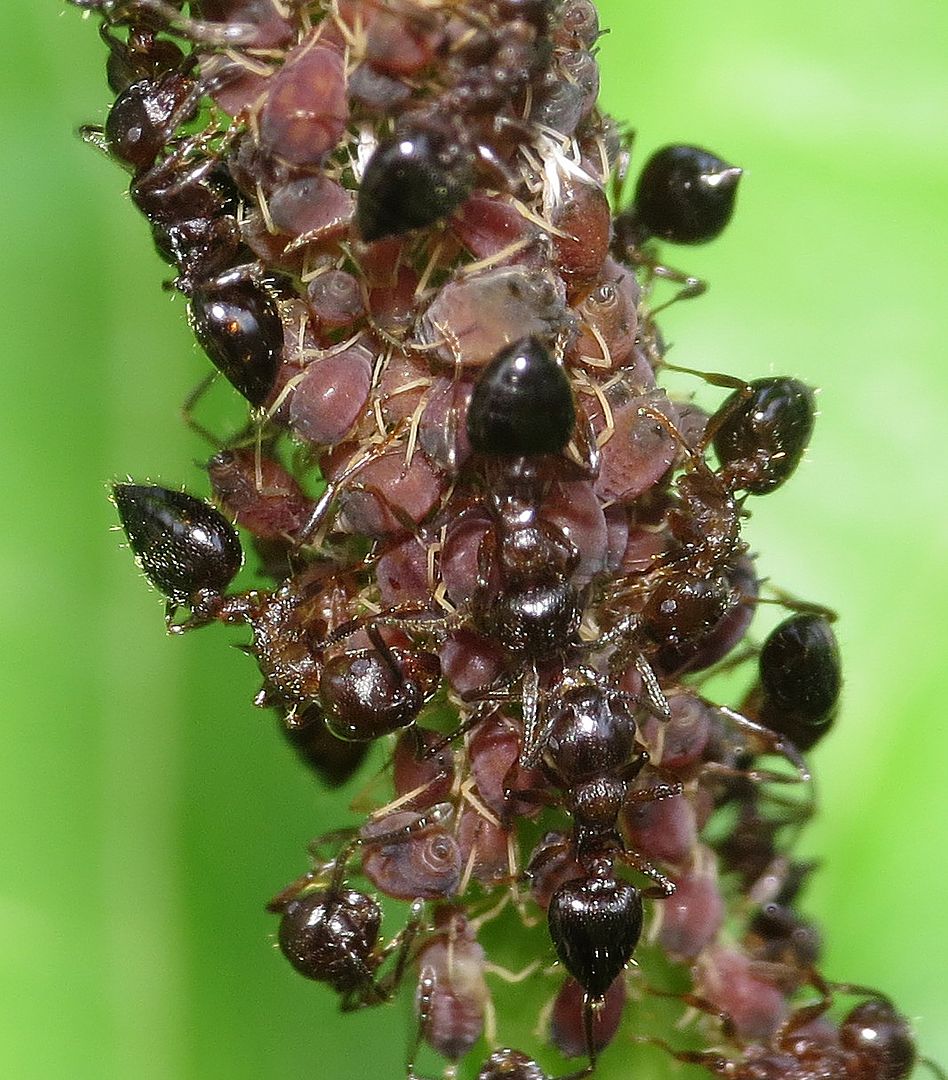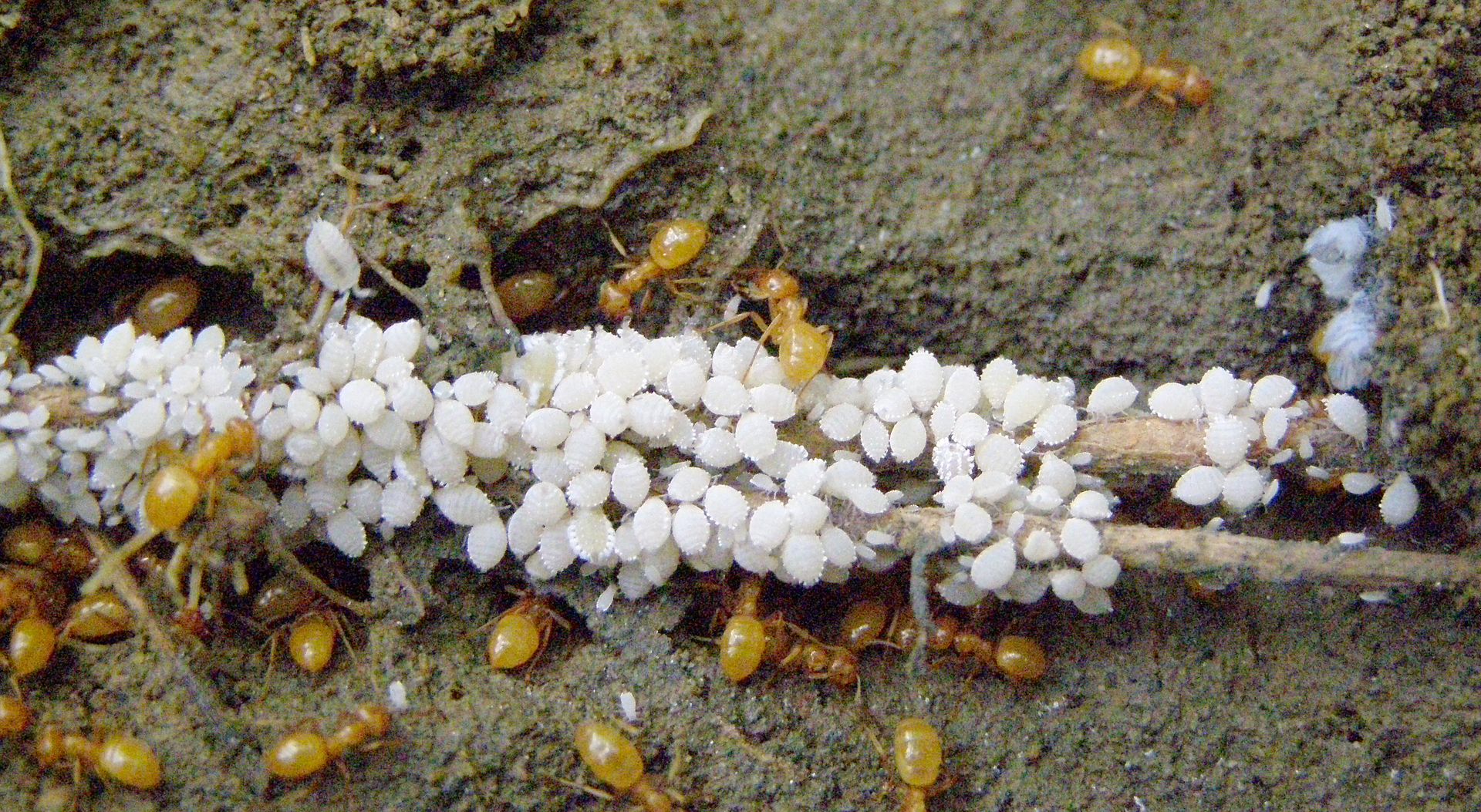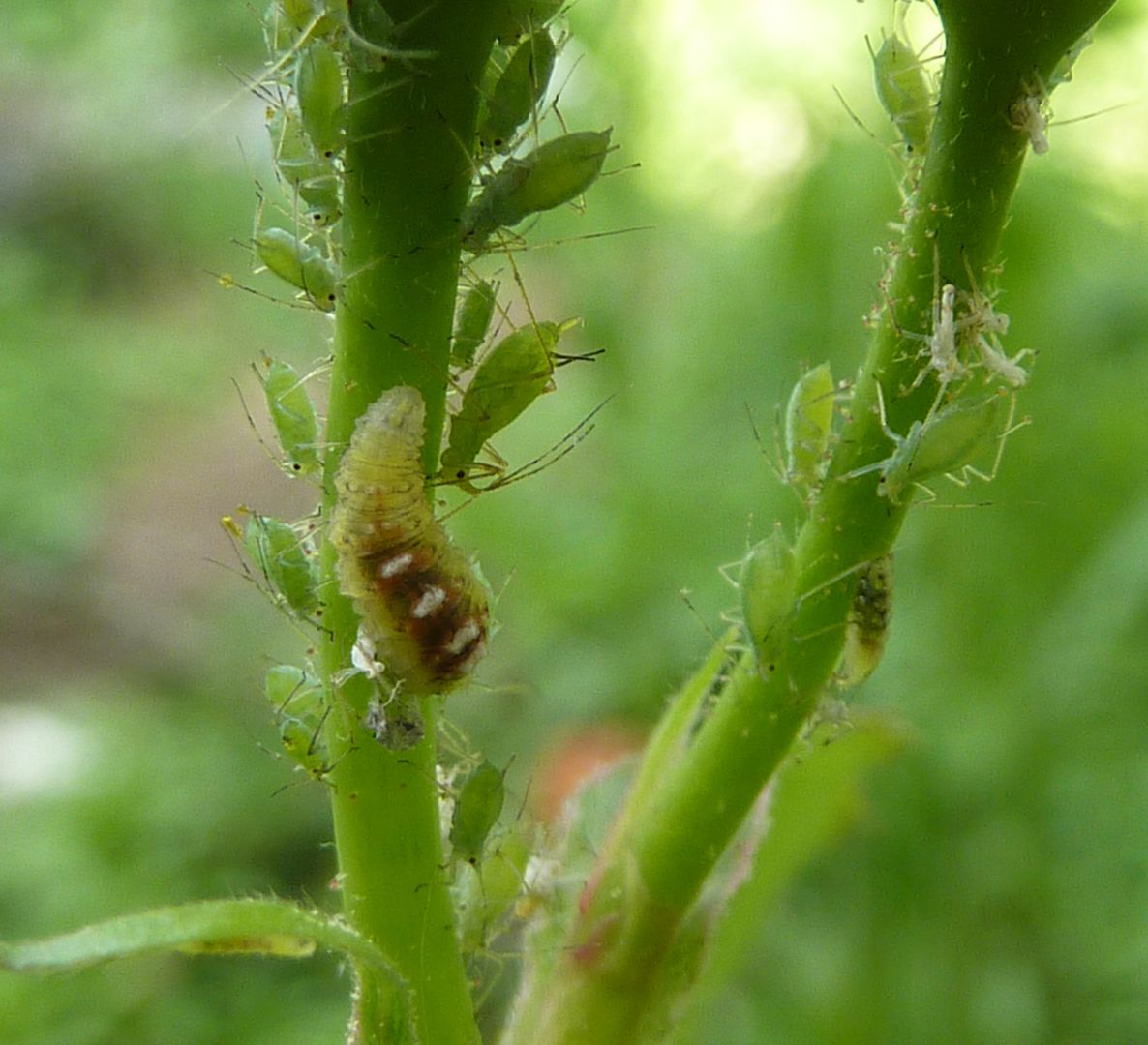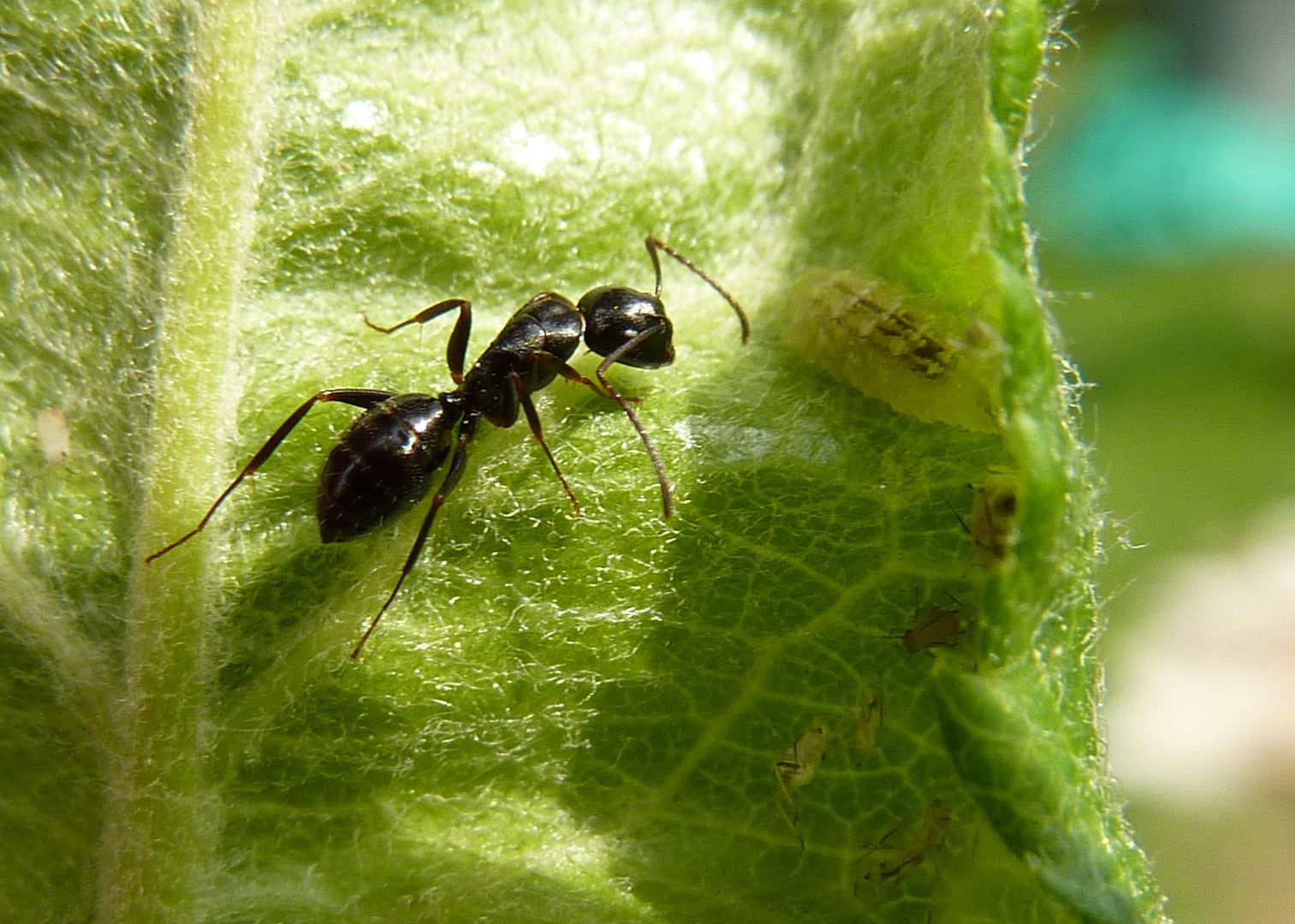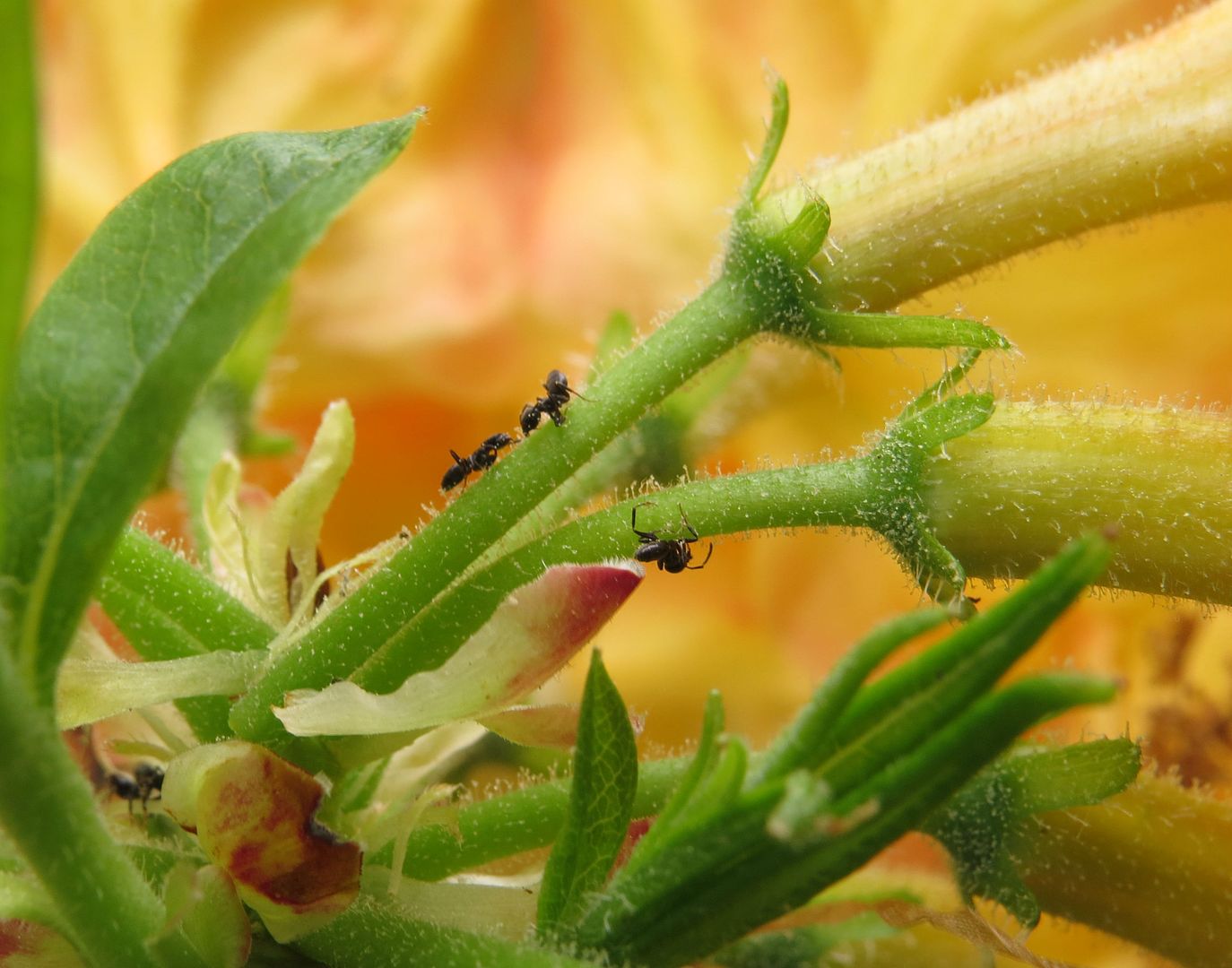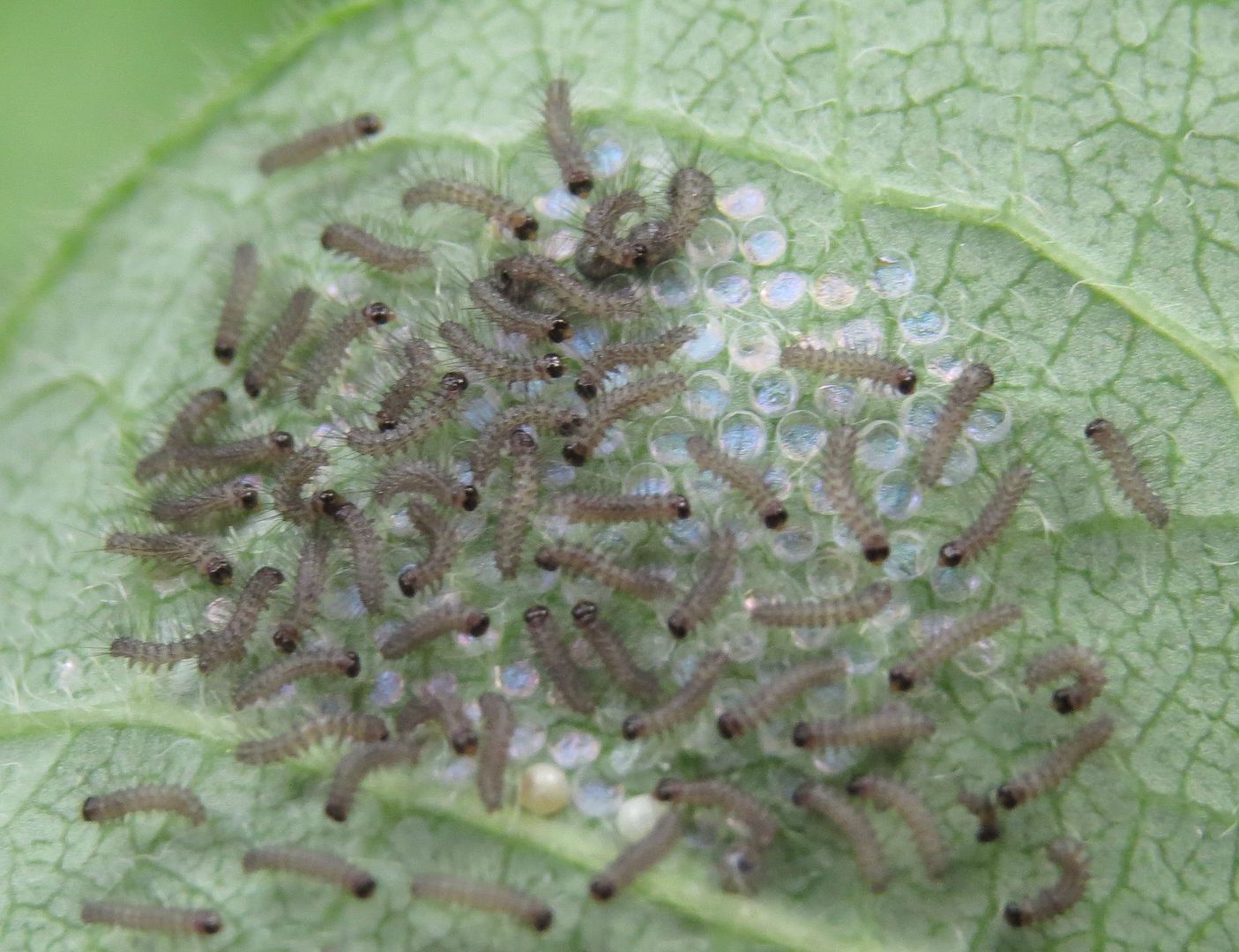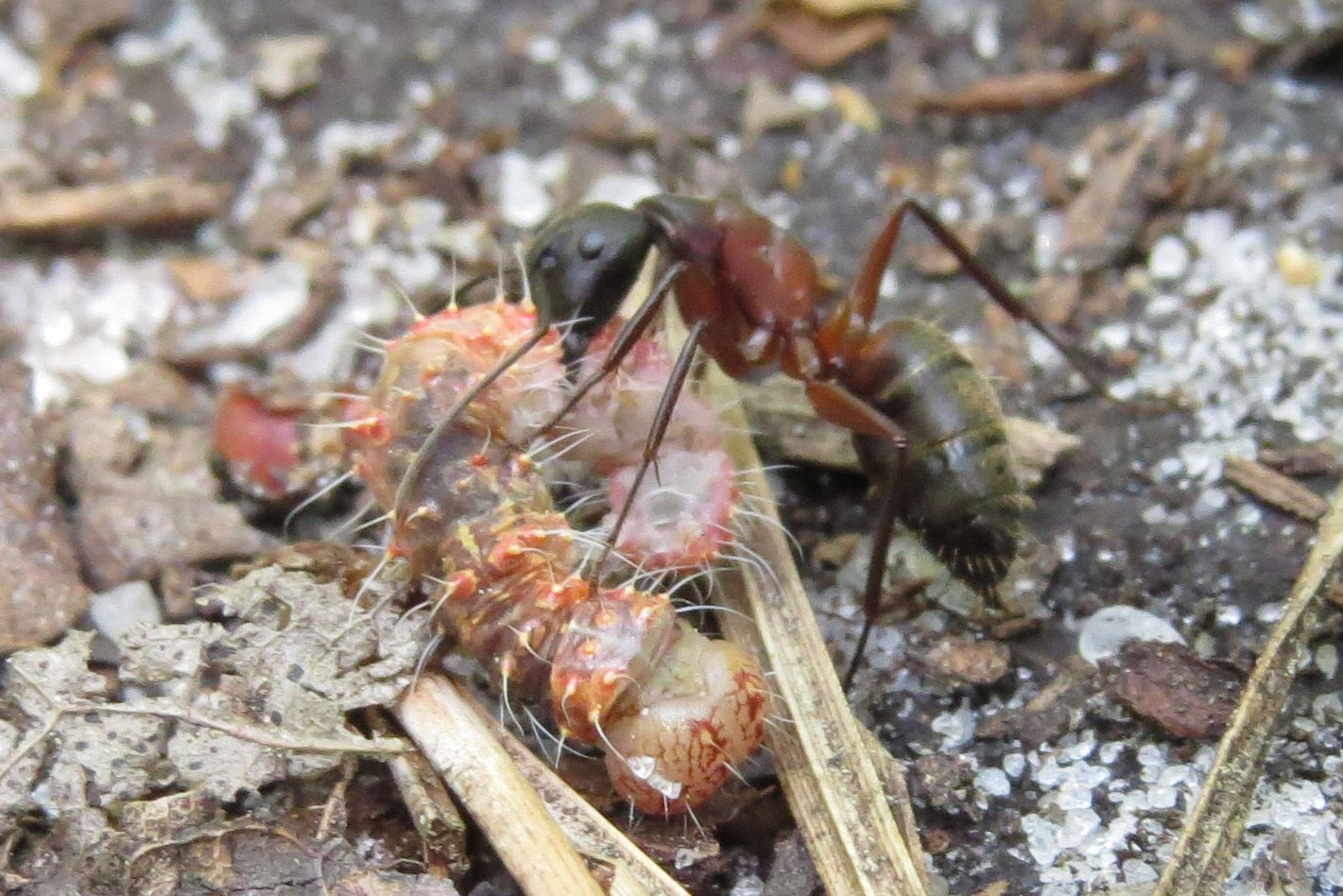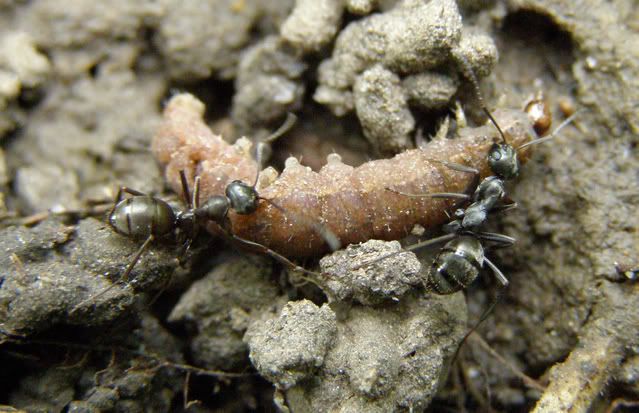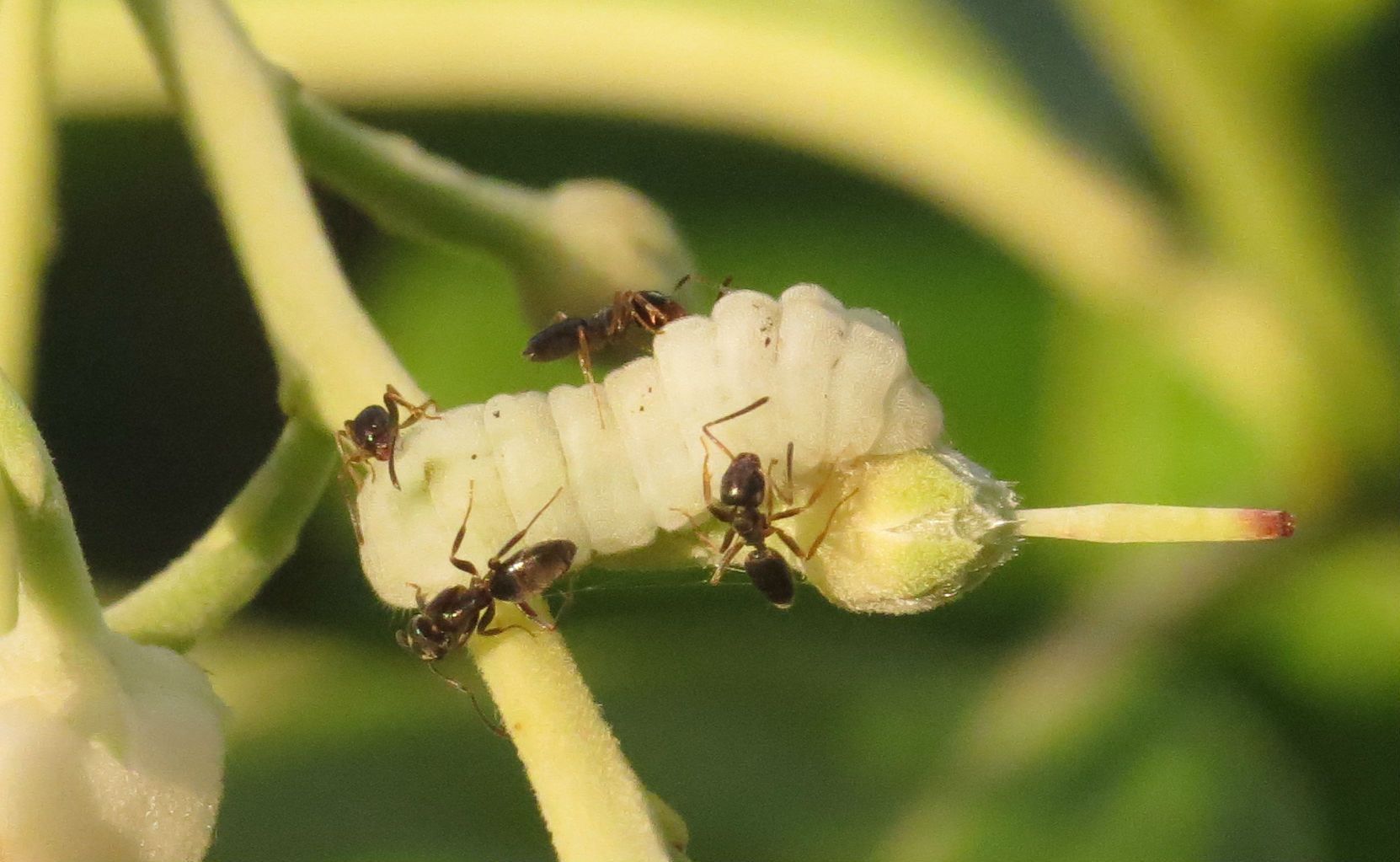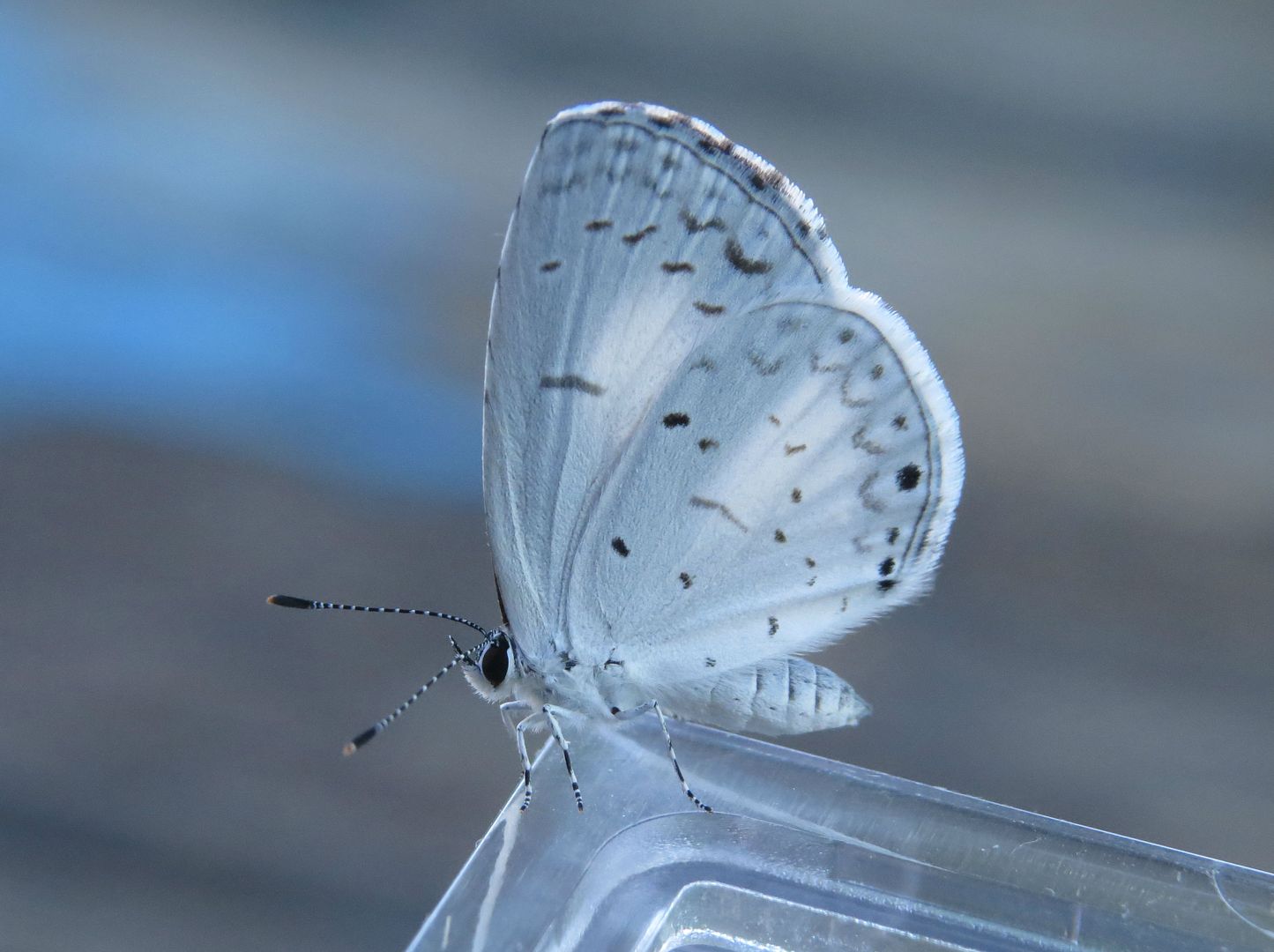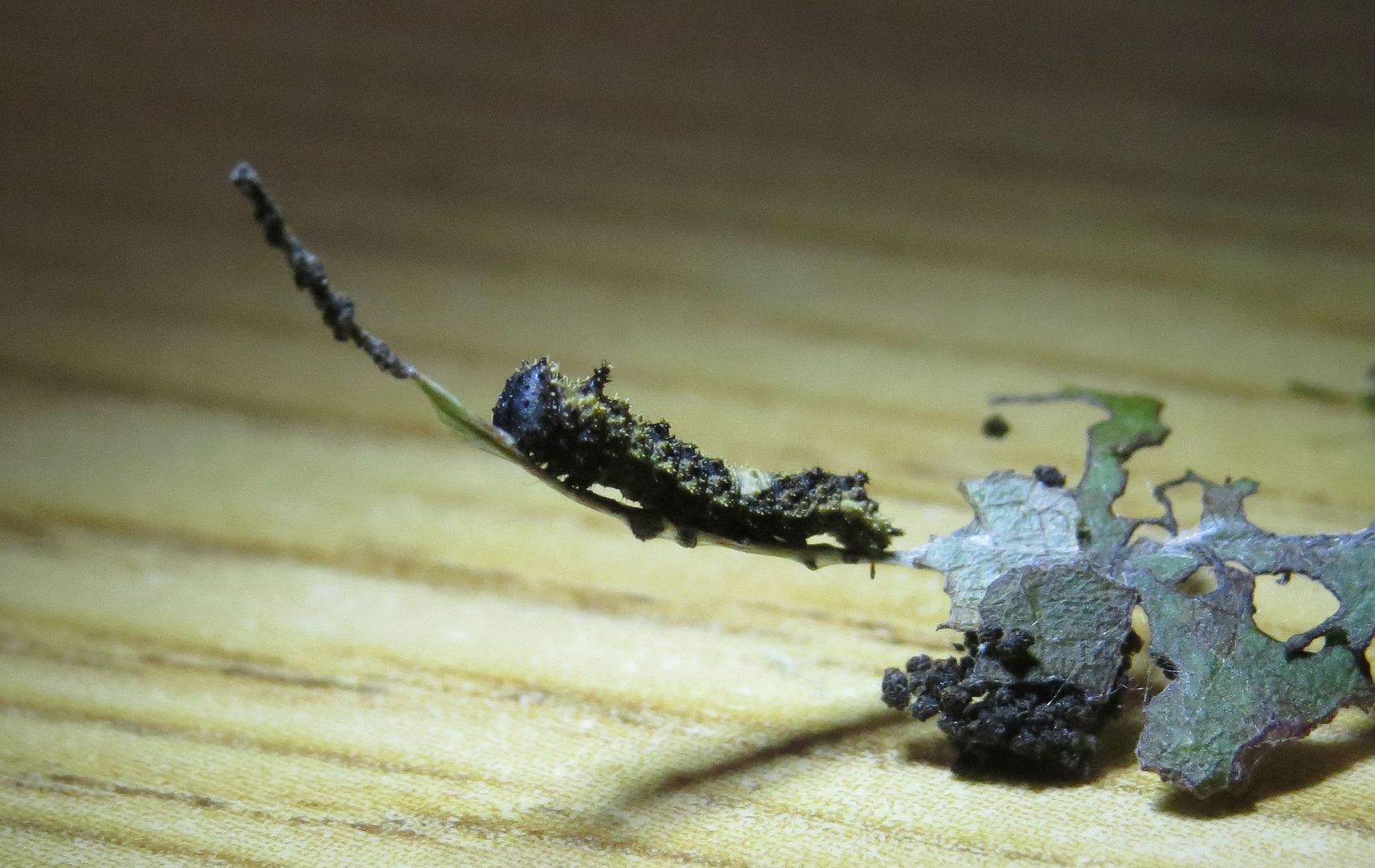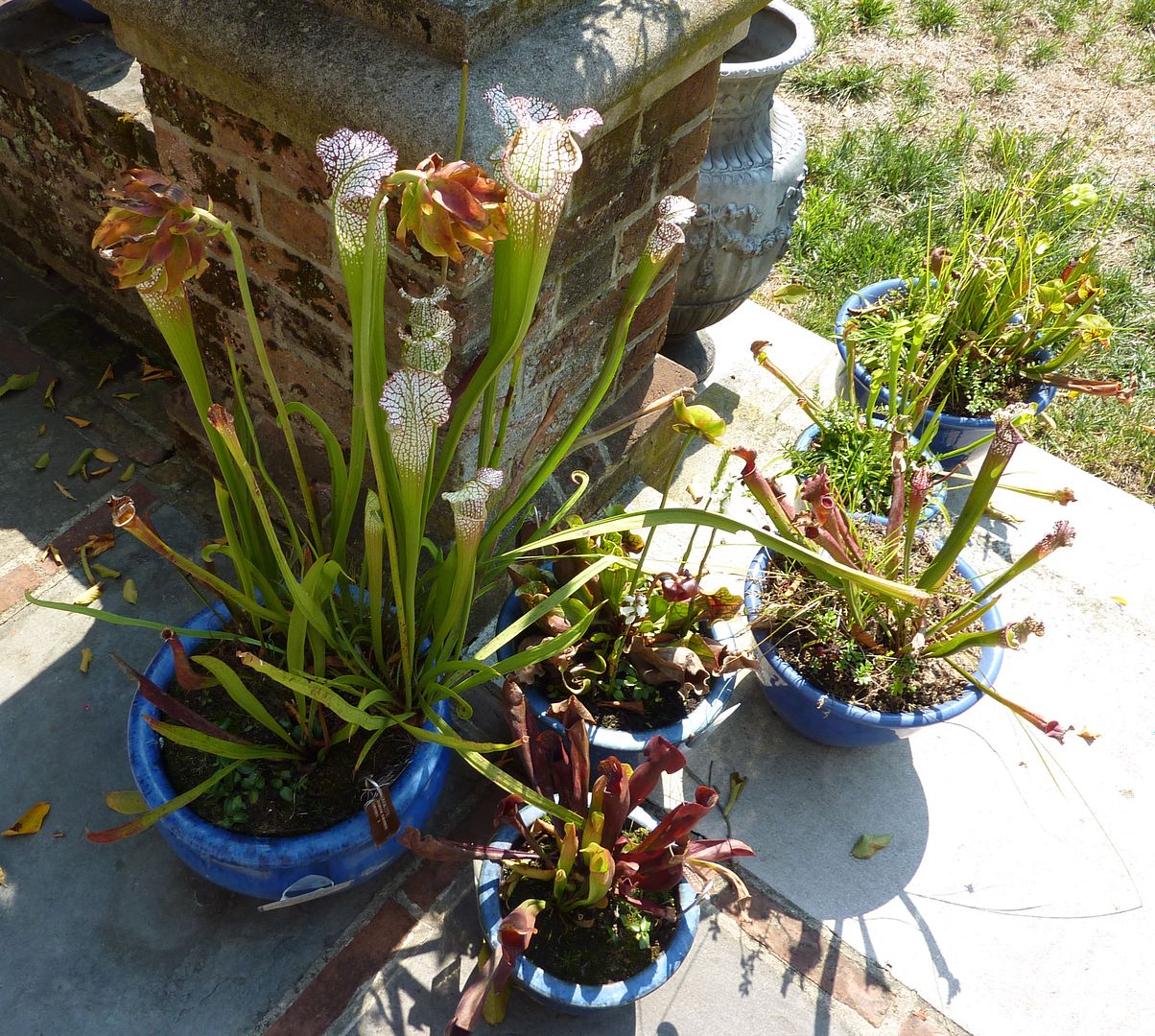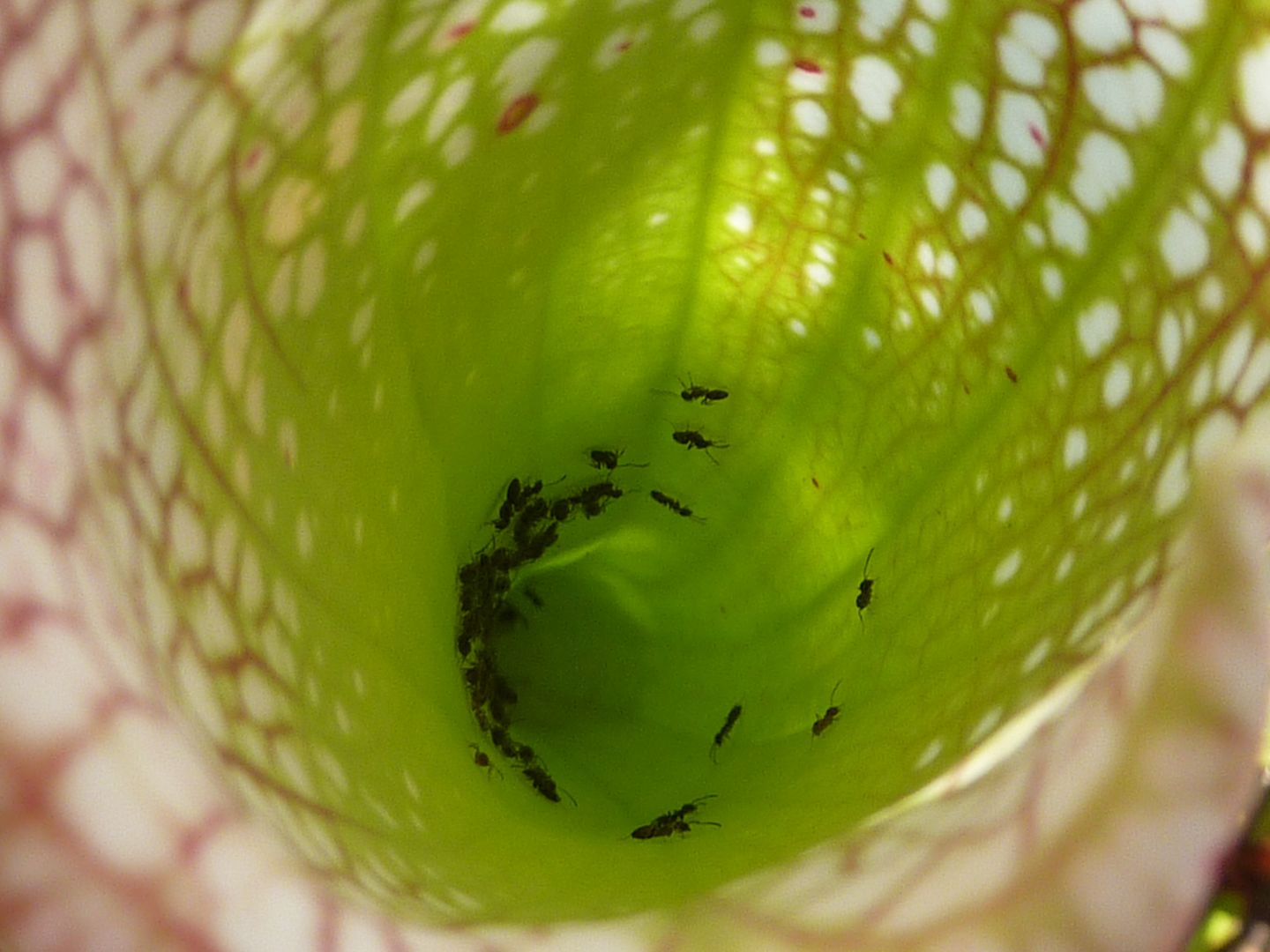Ants in the Attini tribe forage for leaves and other forms of plant matter to feed to their fungus gardens. The fungus in turn produces the ant's food. Not all members of this tribe actually cut leaves though, many favor plant matter that's more easily managed such as spent flower petals and the frass of caterpillars and grasshoppers which is already rich with fertilizer.
Atta is easily the most advanced and well developed of the Leaf Cutter Ants. They form huge colonies from a single queen and grow very large balls of fungus within the earth. Whenever documentaries talk about Leaf Cutter Ants they always seem to focus on this genus.
In the US they occur along the Mexico boarder extending up mostly in Arizona and Texas. While both are an agricultural pest, they provide an important service to the environment. They turn and aerate more soil than earthworms, and the waste produced by their fungus gardens greatly enrich the poor soils found in rain forests.
Colonies of Atta dig out large open chambers in the soil and start their fungus gardens on rocks and the roots of plants. Rarely do you find their gardens touching the soil directly because there is the risk of contamination by foreign pathogens and unwanted fungi. Leaves are chewed into smaller pieces and the fungus gardens themselves become the nest structure. Brood is put directly in contact with the fungus and allowed to feed.
Atta have the most diverse caste system of all ants. Pictured here is the biggest member of the colony, the queen, who is tended by a variety of small to medium sized workers. There are whole castes made specifically for cutting leaves, to be janitors in subterranean dumps, and even a specific caste to fight off army ants.
Trachymyrmex is a more common genus throughout the US. Unlike Atta and Acromyrmex, they're not restricted to the Mexico boarder and parts of California. Their colonies are much smaller though and they their caste system is nothing compared to the diversity in Atta. Queens of Trachymyrmex are barely larger than the workers.
Colonies are much smaller too, possessing only 1 to 4 fungus gardens, typically. There's also a higher focus on collecting fresh plant debris that's already fallen from the plant. They're also far more willing to use caterpillar and grasshopper frass. In Doug Tallamy's "Bringing Nature Home" he lists 535 species of Lepidoptera (moths and butterflies) use Oak trees as host plants alone. That's a lot of crap raining down to the forest floor every day.

Here a Trachymyrmex septentrionalis worker is carrying a piece of caterpillar frass back to the nest.
Trachymyrmex septentrionalis, The Northern Fungus Farming Ant, is the only fungus growing species that is wide spread throughout North America. They can be found as far north as New Jersey, Ohio and California. They favor highly sandy soil in very specific conditions. It's likely their fungus gardens require a certain amount of moisture and need a specific temperature to grow successfully, thus nests only occur in either forest clearings and edges, or along slopes with a certain amount of sunshine.
Seed Harvesting
The two main strategies of surviving the arid parts of the US were to focus either on seeds or nectar storage. Harvester ants, as their name suggests, focused on seeds.
Pogonomyrmex are North America's primary genus of Harvester Ant. They also have a more painful sting than the fire ant, Solenopsis invicta. A lot of ant species collect seeds for food though, but harvester ants do it better than most.
Inside the nest the seeds are stored and eventually ground up to be fed to the larva in the form of "ant bread" which the larvae digest for the adult workers to consume.
The adult workers are also somewhat able to consume solid food (which is uncommon in ants). Seen here from left to right: the crop (social stomach) where the ant stores food it can regurgitate to other members of the colony. Then in the middle we find the midgut, which is a point of no return as far as food is concerned. Food in the midgut can not be regurgitated out again. Inside the midgut though you can see a pile of seed particles which the ant had consumed.
For the most part, adult ants can not consume solid food. But new research has found that some species and or whole subfamilies of ant genera have adult members that can consume solid food.
While the intention has always been to eat the seeds, plants produce them in such great numbers that the ant colony often can't eat all of them. Ant colonies also move about and abandon sections of their nest from time to time. Some species will even carry all theirs seeds up to the surface when they get wet so they can dry out quickly. Colonies are often burdened with so many seeds that some of inevitably start to grow within the ant's nest.
Ant Seed Dispersal (Myrmecochory)
Twinleaf, Jeffersonia diphylla, is easily the most fleeting of our spring ephemerals. Flowers push up before the first set of leaves. Once the flower opens a timer is started where all the petals will fall off between 8 hours and the next 2 days. After that they're gone for good! Planting them on a slope can help prolong the bloom as micro climates will be different at the top and bottom of a hillside. Plants basically grow with the anthers physically touching the stamen. The seed pod resembles an acorn and becomes hidden under the foliage. They split open later and ants disperse the seeds.
Wild Ginger, Asarum canadense, is a commonly sold ground cover in the garden trade. Flowers are pollinated by carrion flies and beetles and thus laid directly on the ground. It's believed the red of the flower is meant to imitate a rotting wound for the insects to crawl into. The flowers smell of death though one has to stick their nose up to them to find that out. The resulting seed pod splits open right on the ground for the ants to come and find.
Erythronium americanum,
Yellow Trout Lily
Erythronium albidum,
White Trout Lily
Trout Lilies don't always flower. Often they favor division to form a vast colony of spotted leaves along the forest floor. When they do flower it's often because they're growing in rocky soil or because their roots can't expand easily outward in any particular direction, thus energy is put towards flowering. A gardening trick is to either treat this as a potted plant or to mix in a few rocks into the soil beneath the plant roots to help encourage this. The resulting seed pod is later laid on the ground for ants to come and find the seeds which have packets of elaiosome on them.
Bloodroot, Sanguinaria canadensis, emerges early in the spring with its leaf clutching its flower stem to help protect it against harsh winds.This species is in the poppy family, thus the flower doesn't produce any nectar, just pollen. After pollination occurs, the flower develops into a seed pod and is laid directly down on the forest floor where it eventually opens for ants to partake of. Bloodroot gets its name from the red sap excreted by the root of the plant.
Woodland Poppy, Stylophorum diphyllum, is probably the easiest ephemeral to grow in North America. Plants produce multiple flowers for a long period of time in the spring, and seed pods are produce well into June and July.
Ants are not required for this plant to spread but seeds are still coated with elaiosome all the same. Unlike other ephemerals this species spreads quick for a woodland plant, with seeds germinating only after one year of dormancy. Plants usually flower from their third year on.
 Trillium erectum, Red Trillium, is a beautiful plant with a bright red flower. Plants are monofloral producing just one bloom if any for the whole year. They're pollinated by carrion flies and beetles, thus the flower smells of rotting fish, thankfully one has to put their nose up to the flower to observe this fact. The seed pod develops at the end of the stem where the flower used to be, often hanging down below the leaves at this time where it eventually opens or falls to the ground for ants to partake of.
Trillium erectum, Red Trillium, is a beautiful plant with a bright red flower. Plants are monofloral producing just one bloom if any for the whole year. They're pollinated by carrion flies and beetles, thus the flower smells of rotting fish, thankfully one has to put their nose up to the flower to observe this fact. The seed pod develops at the end of the stem where the flower used to be, often hanging down below the leaves at this time where it eventually opens or falls to the ground for ants to partake of.Trillium luteum, is one of the few yellow flowering Trillium species. It has a pleasing scent, similar of lemons or oranges. Within the Trillium genus this species falls in the sessile subgroup, which means the flower occurs atop the three leaves, whereas others have a stem separating the flower from the leaves. Beyond this difference the seed pod develops the same way.
Trillium grandiflorum is probably the best known Trillium species. Flowers are robust and white in color for roughly five to seven days before changing color and turning shades of pink and magenta. This is the provinces flower of Ontario, Canada, where it is illegal to pick. A failing of being monofloral is should anything happen to destroy the flower, the plant basically forgoes reproduction for the year.
Trilliums are a prized spring ephemeral in North America. They're also one of the trickiest to grow. Seeds require two years to germinate, where they produce an awful odor, likely meant to get the ants that moved the seed to its location to move on to new nesting grounds. First year's growth for a Trillium is just a single leaf sticking out of the ground, and that's it for the whole year! In following years two leaves come up, then three, then after that they may flower or they may wait an additional number of years before. So Trillium plants take the better half of a decade (up to 15 years!) before reaching a flowering age! Once they're there though, the rhizome (roots) do grow out some and may send up multiple flowering shoots each year to form a clump. But even then it's a long, and slow process that doesn't always go as planned. Pictured above is a Trillium coming up in the middle of my lawn, thanks to ants carrying the seeds off two years prior. Watching the wonders of Myrmecochory is great and all but for the gardener who doesn't want a lawn full of expensive plants, it's best to just collect the seed pod when it's soft (and semi-transparent revealing the seeds inside have turned brown/orange) and just plant them yourself.
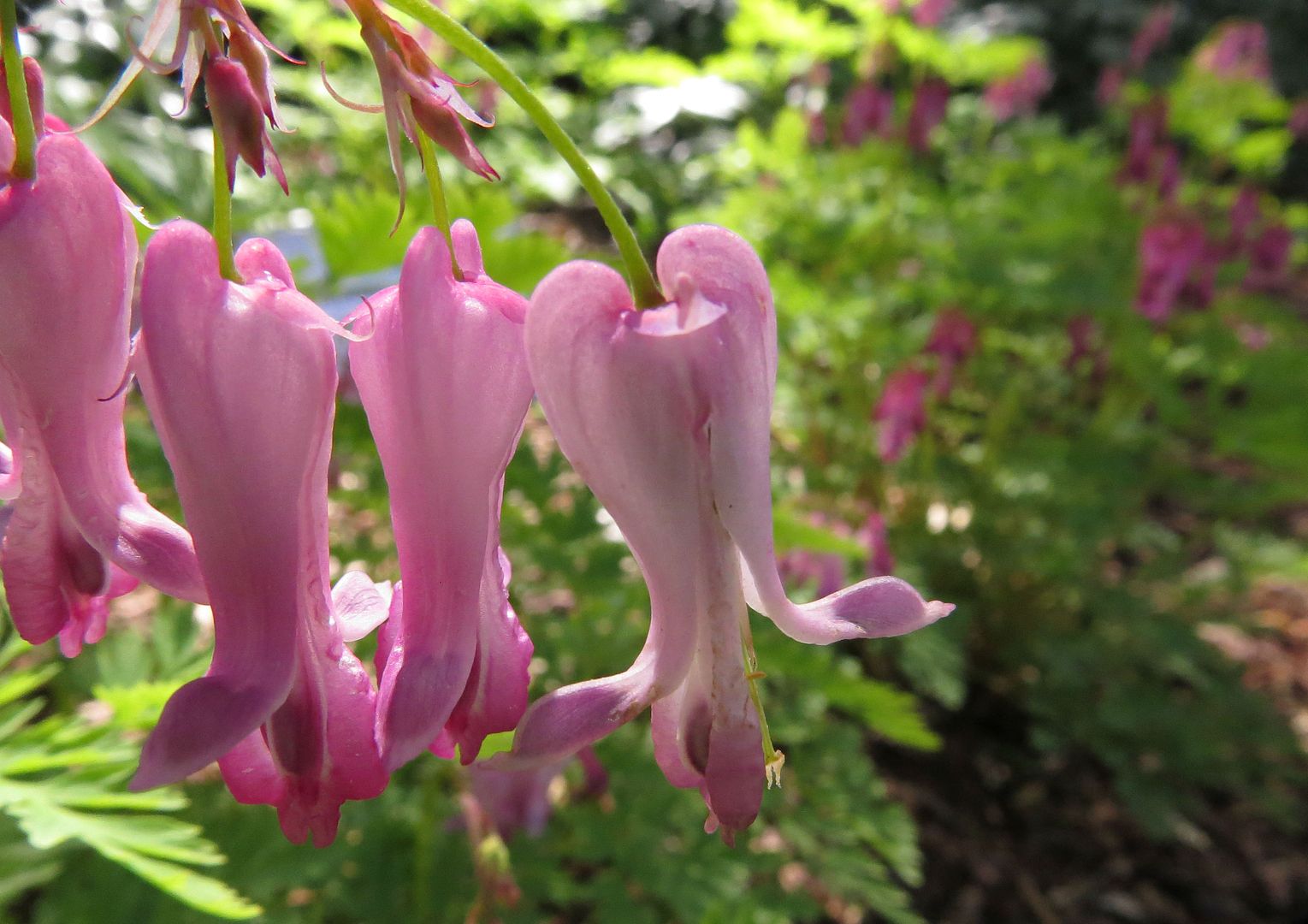 Turkey Corn, Dicentra exima, and Dutchmen's Britches, Dicentra cucullaria are native versions of a plant called Bleeding Hearts. I favor Turkey Corn because it blooms off and on all year long and almost always had a seed pod ready to pick and disperse to the ants.
Turkey Corn, Dicentra exima, and Dutchmen's Britches, Dicentra cucullaria are native versions of a plant called Bleeding Hearts. I favor Turkey Corn because it blooms off and on all year long and almost always had a seed pod ready to pick and disperse to the ants. 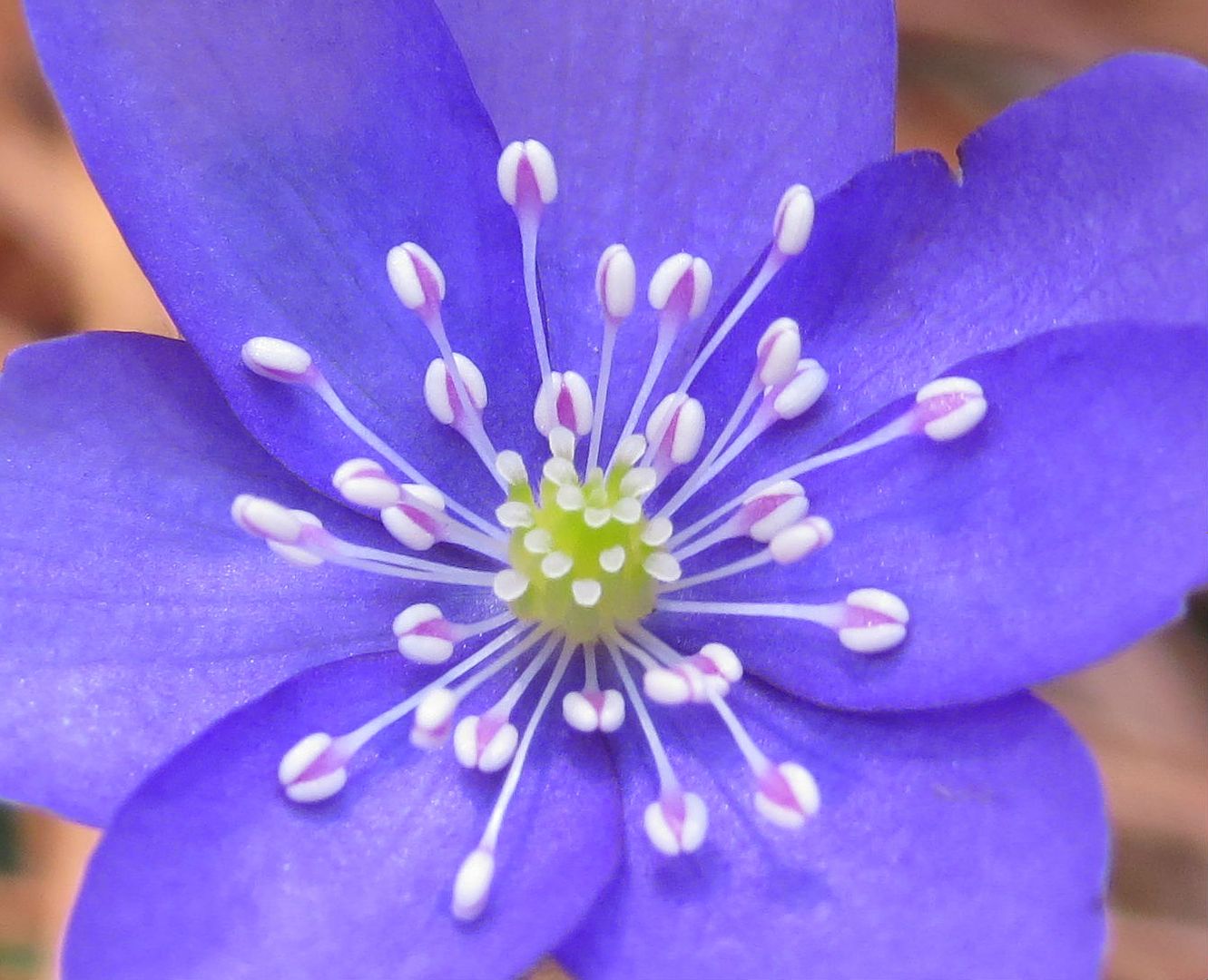

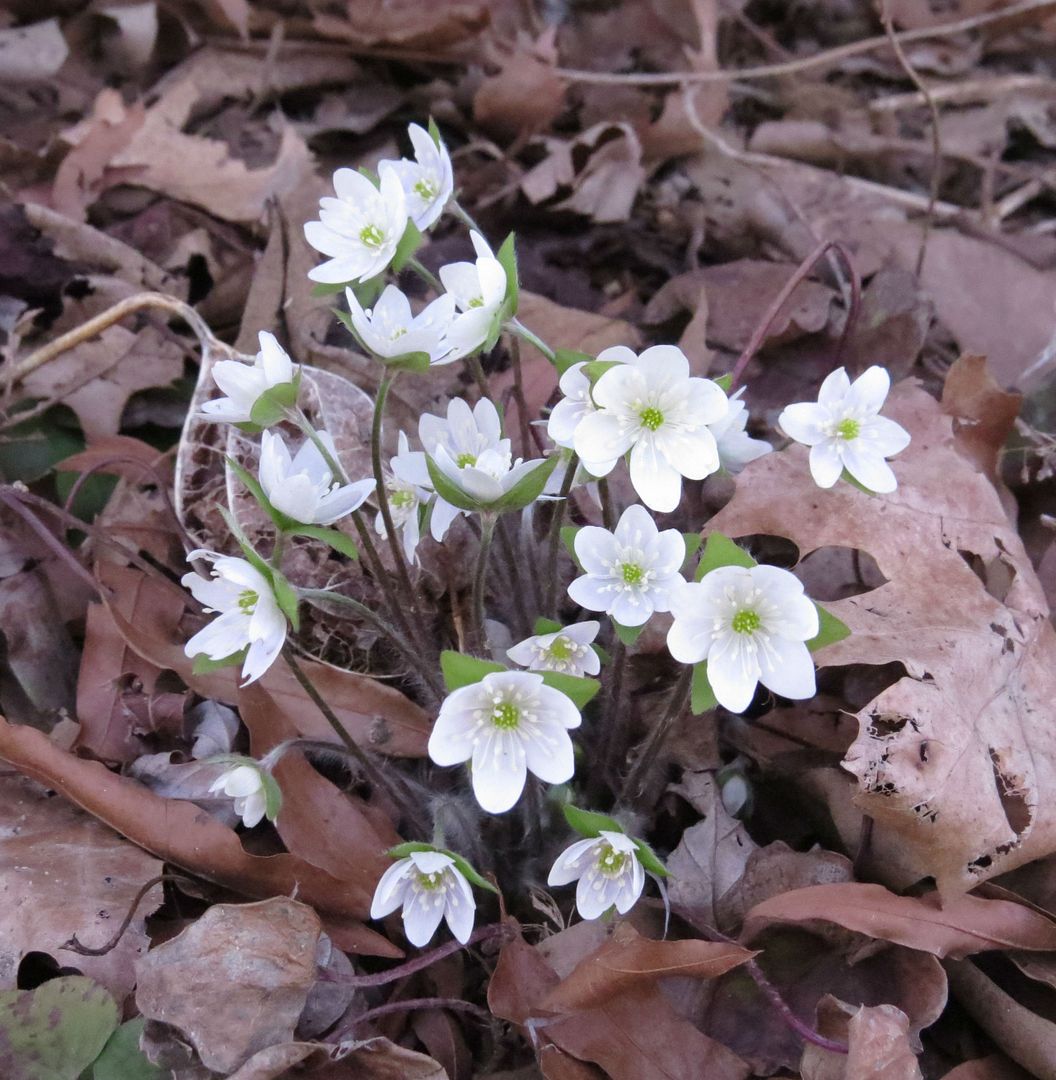 Hepatica, a.k.a. Liver Leaf but I've never heard
anyone refer to it as that. The name hark-ins back to a time when
herbalists believed plants shaped like human organs possessed medicine
to treat ailments relating to that organ. In other words quackery. Hepatica is a semi-evergreen with a charming rosette of leaves around it all
year long. Mid winter though the leaves die off and fade away, making
room for droves of flowers to spring up in late winter, early spring.
New leaves are later formed that last the whole year. Flowers are most often white but shades of blue, pink, and lavender are not uncommon. Seeds form at the
ends of the flower heads as a pointed star-like mace but eventually
break apart into individual seeds tipped with elaiosome on each one.
I've never witnessed ants taking any interest in these though.
Hepatica, a.k.a. Liver Leaf but I've never heard
anyone refer to it as that. The name hark-ins back to a time when
herbalists believed plants shaped like human organs possessed medicine
to treat ailments relating to that organ. In other words quackery. Hepatica is a semi-evergreen with a charming rosette of leaves around it all
year long. Mid winter though the leaves die off and fade away, making
room for droves of flowers to spring up in late winter, early spring.
New leaves are later formed that last the whole year. Flowers are most often white but shades of blue, pink, and lavender are not uncommon. Seeds form at the
ends of the flower heads as a pointed star-like mace but eventually
break apart into individual seeds tipped with elaiosome on each one.
I've never witnessed ants taking any interest in these though. Corydalis sempervirens, along with other Corydalia species also disperse their seeds by ants. This plant is not ephemeral however, but rather a biannual that prefers to grow in rock gardens with little if any real soil. They grow in full sun conditions.
Regardless of what ant species find the seeds thought, the process can still be plagued with issues. Rodents damage seedpods before they are ripe, wasps are more than happy to carry the seeds off, and even when ants do find the seeds there's no guarantee that the ant is actually going to carry the seed anywhere.
A damaged Trillium seedpod is an open buffet. The majority of ant species that find the seeds would rather feed on the eliasome in place than bother carrying the seeds back home with them. Here Camponotus subbarbatus workers collect the nutrients from the elaiosome until they're completely dry, but not one of them bothered to move the seeds anywhere. Crematogaster and Nylanderia both do the same thing.
Pictured to the right are two A. rudis workers carrying an unripe Twinleaf seed home. The seedpod became damaged before the seeds were ready, but the elaiosome still triggered them to carry the seed off.
The issue seems to be a matter of size. The most ideal ant genus I've found up for the job in the US anything in the genus Aphaenogaster. It's very likely the similar Myrmica species also do a good job but I haven't had a chance to test that. I've also seen Formica and some members of the Camponotus genus also work but many of these don't nest in ideal locations. That's not necessarily a bad thing though. Seeds are often discarded out of the nest. But if they're abandoned inside a dead log, the seed doesn't have much chance to grow as early as it would like to.
Aphaenogaster rudis, carrying home the seed to a Woodland Poppy. I notice how the elaiosome to this species vaguely resembles ant brood but I'm not aware of this serving any particular purpose.
Turkey Corn, Dicentra exima, is another plant I've had success with getting Apheanogaster to take an interest in. Thus far though I have not seen any new plants sprouting out of the ground.
An Acorn Ant, Temnothorax curvispinosus, feeding on the elaiosome to a Woodland Poppy seed. It's probably best this ant didn't take this seed home. Acorn Ants, true to their name, sometimes nest inside of hollow acorns. To be honest though I wouldn't put it past Woodland Poppy of all plants to grow out of one.
Fruit Consumption
Many plants have seeds housed within fleshy bodies of fruit. While ants are not the direct distribute of such plants they do play a roll in removing the flesh of fallen fruit. North America lacks too many good examples of this but some species around the globe will actually build a dirt dome over the fruit for protection while they remove the flesh from the seed... essentially planting it.
Ant Pollination
Ant Pollination is a tricky topic because it implies the plant evolved to be pollinated specifically by ants instead of the more efficient bees, beetles, flies, birds and bats. There are three plant species native to the U.S. known to be pollinated by ants and are listed as follows: Paronychia pulvinata, Diamorpha smallii, and Polygonum cascadense. In all three cases the pollinator was a member of the genus Formica. In all three cases, plants were species that grew very low to the ground so the ants could easily move from one plant to the other. Often the plants were of a creeping habit, and possessed an abundance of flowers that all had a simple in structure to them.
Ants are believed to be terrible pollinators because they're coated in a type of antibiotic that destroys pollen on contact. I contest though a single ant can only be coated in so much of this chemical before the pollen it is rendered useless, and that pollen to some plants can surely attach itself to the ant's hairs or otherwise cake onto the ant's body.
Some species that did not evolve to be pollinated by ants still possess some fairly simple flower structures. Holly trees for example produce hundreds of small fairly simply flowers. Each year I watch as a shrub in our yard is dominated by three different ant species. Crematogaster cerasi, Camponotus nearcticus, and Tapinoma sessile, often all at once with the Crematogaster dominating. Each year the plant still manages to produce a crop of berries. Technically the plant is self pollinating though as there are no other Holly trees around for the ants to exchange the pollen with.
Stealing Nectar
In the deserts of the southwest, nectar is a hot commodity. Ants in genus Myrmecocystus have a special "Replete" caste that earns then the name Honey-pot Ant. Individual workers are fed nectar to such an extent that it causes their crops to balloon up to a gigantic size, revealing the soft membrane beneath and separating the plates that make up the ant's gaster (abdomen).
An Odorous House Ant, Tapinoma sessile, climbing the stalk to steal nectar from a Spring Beauty, a common lawn appropriate wildflower.
Odorous House Ants, Tapinoma sessile stealing nectar from Purple Milkweed, Asclepias purpurascens, an uncommon and often hard to grow perennial. Unlike most other Milkweed species, Purple Milkweed requires cross pollination with a different plant in order to produce viable seed. Unfortunately it's things as simple as this that discourage pollinators from even visiting the flowers.
The very small Nylanderia faisonensis stealing nectar from the blooms of an Obedient Plant.
Odorous House Ants, Tapinoma sessile, stealing nectar from the insides of a blueberry flower.
Extrafloral Nectar and Nectar Scraping
Rather than worry about ants stealing nectar from their flowers, some plants have nectar secreting structures on them to attract ants to them. The flowers to this sweet pea are pinched closed and require a bee to force them open for the bee to get at the nectar. This keeps the flower nectar secure from the ants as well. But also at the base of each flower is a pore that excretes extrafloral nectar.
The large buds to the nonnative Peonie plant are absolutely dripping with delicious sap that attracts ants to come protect the bud from any harm.
 Many
plants are coated in a thin layer of nectar which the ants collect by
"nectar scraping." This most often occurs on the leaves and new growth,
but some plants have evolved to help protect their flower buds by
coating them in a thin layer of sweet plant sap. This is the help defend
against certain types of moths that lay their eggs directly in the
unopened flower buds of certain plants. Without the ants protecting the
flower bud, the resulting caterpillar is free to burrow into a flower
bud and consume the reproductive parts before the bud has a chance to
open.
Many
plants are coated in a thin layer of nectar which the ants collect by
"nectar scraping." This most often occurs on the leaves and new growth,
but some plants have evolved to help protect their flower buds by
coating them in a thin layer of sweet plant sap. This is the help defend
against certain types of moths that lay their eggs directly in the
unopened flower buds of certain plants. Without the ants protecting the
flower bud, the resulting caterpillar is free to burrow into a flower
bud and consume the reproductive parts before the bud has a chance to
open.The large flowers of a trumpet vine offer up extrafloral nectar to attract ants to the buds. When the flowers open though the ants are free to steal real nectar from the flower. The plant doesn't care though because its pollinated by hummingbirds which are more than happy to eat the ants.
Hemipterans (Aphids, Scales and Mealy Bugs)
In the absence of rich flower nectar or pores specifically designed to feed ants, aphids and other types of dew producing insects may provide the "service" to the plant. I say "service" because the host plant in question doesn't have any real way of regulating how many aphids, scales, or mealy bugs infest the plant.
Some ants do not feed directly from aphids, but rather favor the dew that rains down lower foliage. While this does not protect the aphids directly, it does cause more ants to forage on the plant which in theory reduces the number of predators about. Formica subsericea and F. pallidefulva are both known to favor nectar scraping as opposed to direct tending. Also though, I've never noticed ants of any kind tending this particular species of aphid.
Tree Hoppers on the underside of a Sunflower leaf being tended by Camponotus subbarbatus.
Camponotus nearcticus tending green aphids which nestle themselves in the open florets of a Black-eyed Susan.
Lasius alienus workers tending aphids on Golden Alexander, Zizia aurea. Oddly enough this species seems to vanish or more onto a different host plant after flowering has finished. A different species then occurs on the plant around the seed pods.
A Camponotus spp. worker tending some small green aphids on the seed pods to Golden Alexander, Zizia aurea.
Ants protect their herds when they can. In this case the workers of Crematogaster cf. cerasi have actually built a structure around a group of aphids sipping at the flower nodes (now gone to seed) of an Eastern Redbud.

The rather large workers of Formica integra tending aphids and very willing to guard them to the last! This species spray formic acid when disturbed and has a powerful bite.
Formica integra colonies (among other species in the genus) form such huge colonies that trunk trails are formed between the nest and various plants where their aphid herds feed. It's likely that even in the winter time, the ants will collect the eggs laid by the aphids to maintain their breeding cattle.
Underground Root Aphids are tended by Citronella Ants, Lasius claviger. Each autumn the ants collect the aphid's eggs to replenish their herds each spring. An observation I chanced upon was a population of Blue Woolly Aphids. I suspect the Woolly Aphids were laying eggs for the L. claviger to care for in the winter as well.
Just because ants are protecting a herd of aphids though doesn't mean the aphids are safe. A number of specialized predators and parasites have evolved ways to get around the ant's harassment and aggression.
Here the larva of a hoverfly moves through the herd undetected where it consumes the aphids one by one. The ants do nothing to stop this.
Plant Defenses Against Ants
Ants stealing nectar is a big problem and many plants have developed defenses to help prevent it from happening. Here a Flame Azalea, Rhododendron calendulaceum, has the stems leading up to its flowers covered in special hairs that produce a sticky sap, stopping the ants in their tracks. Coating the back of the flower also offers a tasty treat to any hummingbirds that may show up to the flowers looking for a meal.
Royal Catchfly, Silene regia, has a similar strategy, offering up tiny gnats, small insects, and oddly enough male ants to the hummingbirds when they come.
Caterpillars Ant Interactions
The majority of ant caterpillar interactions end with the ant killing the caterpillars or removing the eggs directly from the host plant. Pictured above is a clutch of some type of caterpillar that uses Persimmons as a host plant. The strategy the caterpillars are using is safety in numbers, however the strategy never got off the ground. A single Camponotus pennsylvanicus workers came along and chewed them all up into a single ball of pulp that it then returned to the nest. Had these caterpillars been given a week or two to develop they would have been heavily armored, covered in prickly hairs, and likely several times larger than the ants that would eat them.
Caterpillars are a large part of the diet for an ant colony. Often they go for the early instars though before any real defense can be mounted. Monarch caterpillars for example don't really become toxic until the second or third instar. Until then, they're picked off by ants and spiders all day long. Many caterpillar species don't ever become poisonous and instead focus on camouflage so they're not eaten by birds. This offers little defense against ants though which are almost always looking for them.
There are actually species of caterpillars that catapult their frass away from them specifically to lore ants in that direction.
Some caterpillars have learned to take advantage of a good thing though. Here these Odorous House Ants, Tapinoma sessile, were devoting their time to stealing nectar from the flowers of this Sourwood tree. But when the ants found this Spring Azure (Summer Azure?) that all changed. Chemicals excreted by the caterpillar cause the ants to favor tending it over stealing nectar from the flowers... which the caterpillar was also eating. They stayed with the caterpillar until it was ready to form a chrysalis.
Some species of Butterfly in this subfamily later switch from feeding on the plant matter to feeding on the ant brood and are escorted into the nest where they go on to mimic the brood they feed on as well as sounds a queen ant would make when demanding food. Not all species have to over winter within an ant nest, but those that do are often threatened or endangered. Not only do they require the right host plant(s) but also the right host ants. So you can have a pristine meadow of host plants but if the wrong species of ant is present this might break the chain.
I don't know of any particular examples of ants not working out as hosts, but many species find butterfly eggs to be a food source, so if something invasive moves in, such as the Red Imported Fire Ant, Solenopsis invicta, they may be more preference at removing the eggs right off the host plant. I'm sure native ant species do this as well, but it's unlikely to be done on such a scale to eradicate the population.
Here is the adult form of the white caterpillar above. It emerged out of a chrysalis that was scarcely bigger than a peanut.
Early instars of Limenitis arthemis, Red Spotted Purples, construct a stick out of silk and their own frass at the tips of the leaves they consume. Ants do not walk over this structure, and caterpillars will flee back to it once they sense the ants coming. However, this doesn't work all the time. I suspect some species of ants are able to reach them better than others. I say this because of the video below and my own experience.
Doug Tallamy's Black Cherry Trees are completely defoliated thanks to Red Spotted Purple and a few other species. I have a Black Cherry of similar height in my yard but it's never been defoliated. All of the leaves do have some amount of caterpillar damage (a distinctive chewing line cut out through the leaf) but I never see any Red Spotted Purples making it past the first instar. I believe this is thanks to two species of Camponotus and a Formica that forage on the plant all day and night.
Carnivorous Plants
